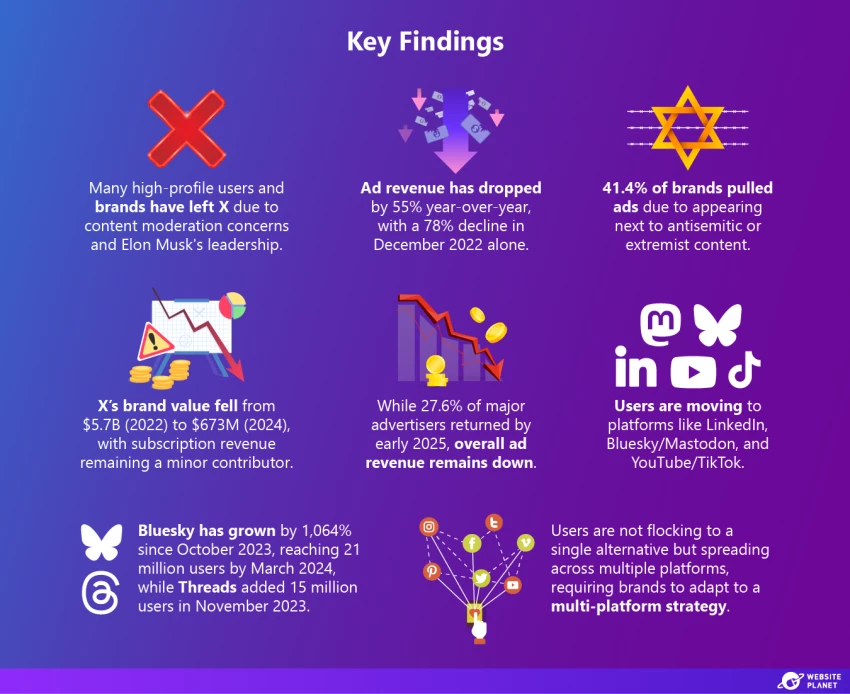Inside this Article
Big Picture: Layoff Trends From 2020–2023

Layoffs in 2020
Since 2020, the first year of COVID-19’s impact on the global economy, the tech sector has gone through a few ups and downs.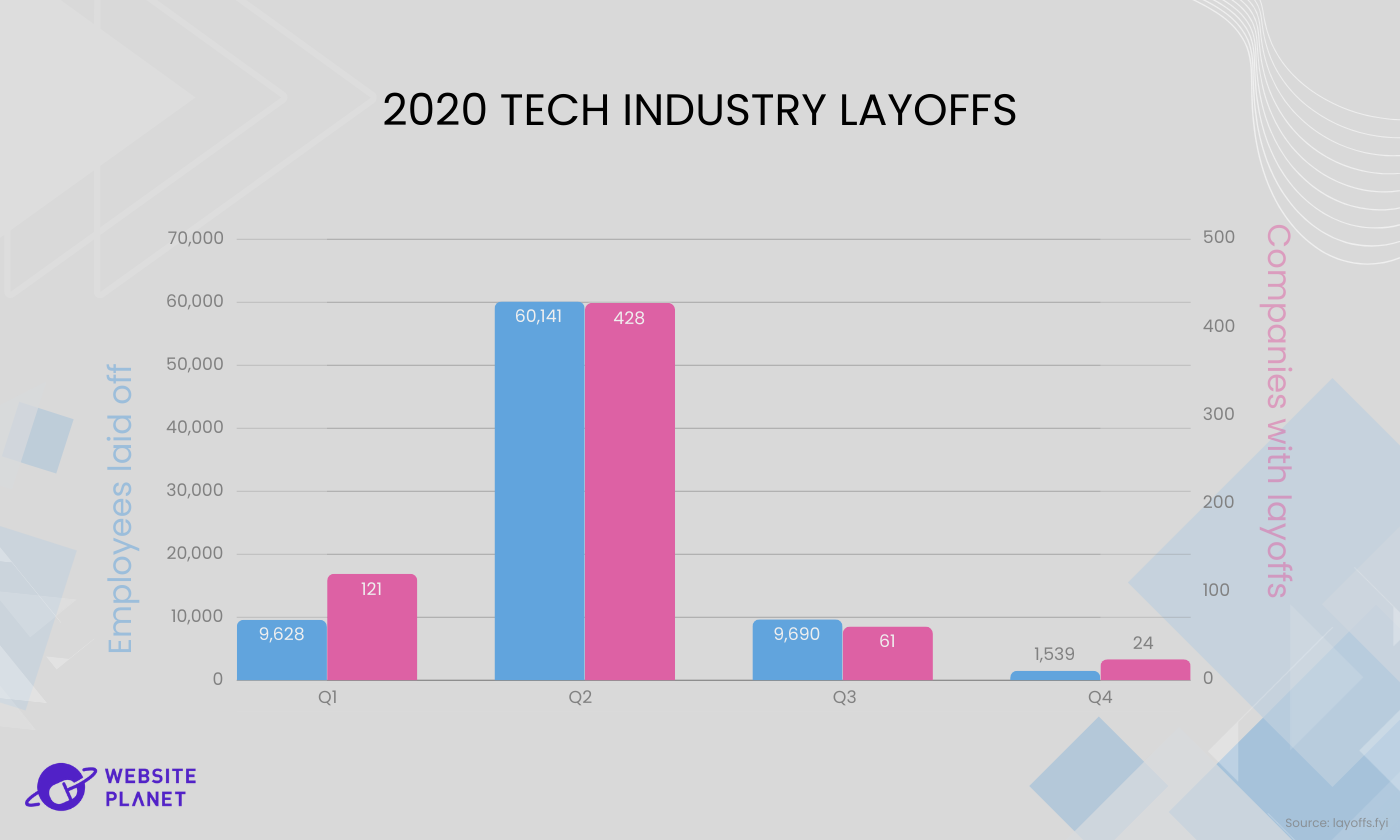 In the tech sector, a total of 80,998 employees were laid off in 2020 according to layoffs.fyi, a site that has been tracking tech layoffs since 2020. Particularly, 74% of those jobs were lost in Q2. The transportation and travel sub-sectors made up 35% of total layoffs for the year. They were most impacted in Q2 due to travel restrictions (at international, national, and state levels), consumer hesitancy, and work-from-home policies meant to stop the rapid spread of COVID-19.
In the tech sector, a total of 80,998 employees were laid off in 2020 according to layoffs.fyi, a site that has been tracking tech layoffs since 2020. Particularly, 74% of those jobs were lost in Q2. The transportation and travel sub-sectors made up 35% of total layoffs for the year. They were most impacted in Q2 due to travel restrictions (at international, national, and state levels), consumer hesitancy, and work-from-home policies meant to stop the rapid spread of COVID-19.
Layoffs in 2021
In 2021, conditions stabilized for the tech sector under a new COVID normal. From Q2 to Q4, layoffs were very low, partly due to the rock-bottom interest rates set by many countries’ central banks to help prop up their economies.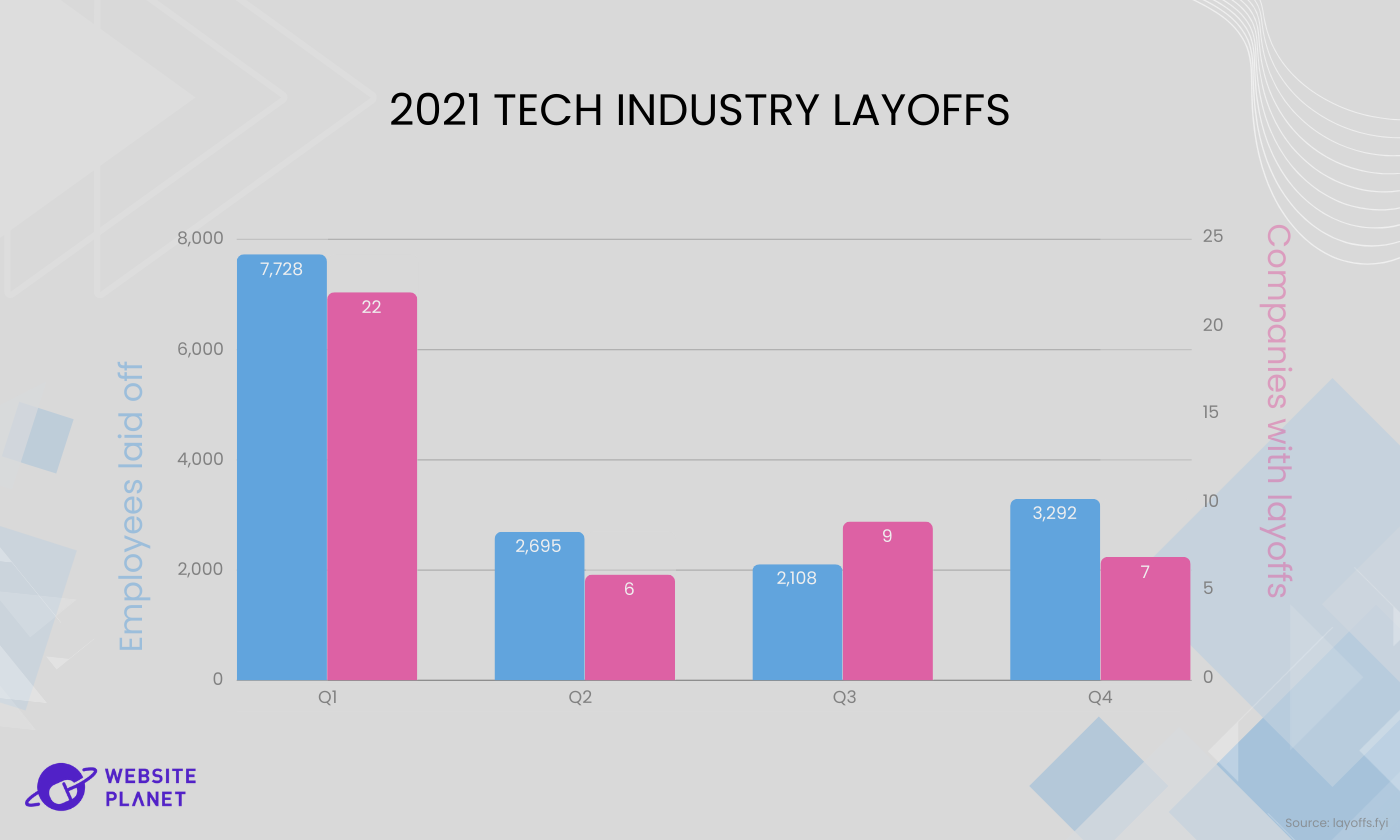 “Only” 15,823 employees from the tech sector were laid off in 2021 — we say “only” because that figure is 80% lower than in 2020. Similarly, “only” around 40 tech companies downsized their workforce. This is 93% fewer than the 634 firms that cut employees in 2020.
“Only” 15,823 employees from the tech sector were laid off in 2021 — we say “only” because that figure is 80% lower than in 2020. Similarly, “only” around 40 tech companies downsized their workforce. This is 93% fewer than the 634 firms that cut employees in 2020.
Layoffs in 2022
Even as countries opened their borders and returned to business as usual in 2022, the economy continued to face challenges. The global supply chain had not yet returned to pre-pandemic norms, causing inflation to rise. This was exacerbated by the war in Ukraine and the subsequent sanctions against Russia, which caused oil and gas prices to soar. In response, central banks were quick to raise interest rates to slow the pace of inflation, which dented the borrowing and spending power of both businesses and consumers. With unfavorable business conditions and dwindling consumer demand, the tech sector had to let go of around 165,000 employees in 2022, representing a 1,040% YoY increase in job losses. That’s 170% more jobs lost than in 2020 and 2021 combined. The retail and consumer sub-sectors saw the biggest layoffs, as non-essential spending was slashed.
With unfavorable business conditions and dwindling consumer demand, the tech sector had to let go of around 165,000 employees in 2022, representing a 1,040% YoY increase in job losses. That’s 170% more jobs lost than in 2020 and 2021 combined. The retail and consumer sub-sectors saw the biggest layoffs, as non-essential spending was slashed.
Layoffs in 2023
Workforce reduction statistics continued to rise in the beginning of 2023, with Q1 seeing the highest recorded layoffs since 2020. Just in the first quarter, over 167,000 employees lost their jobs — that means that more workers were laid off in this single quarter than in the entirety of 2022. Over 570 companies culled their staff headcount, with the retail, consumer, and hardware sectors suffering the biggest losses.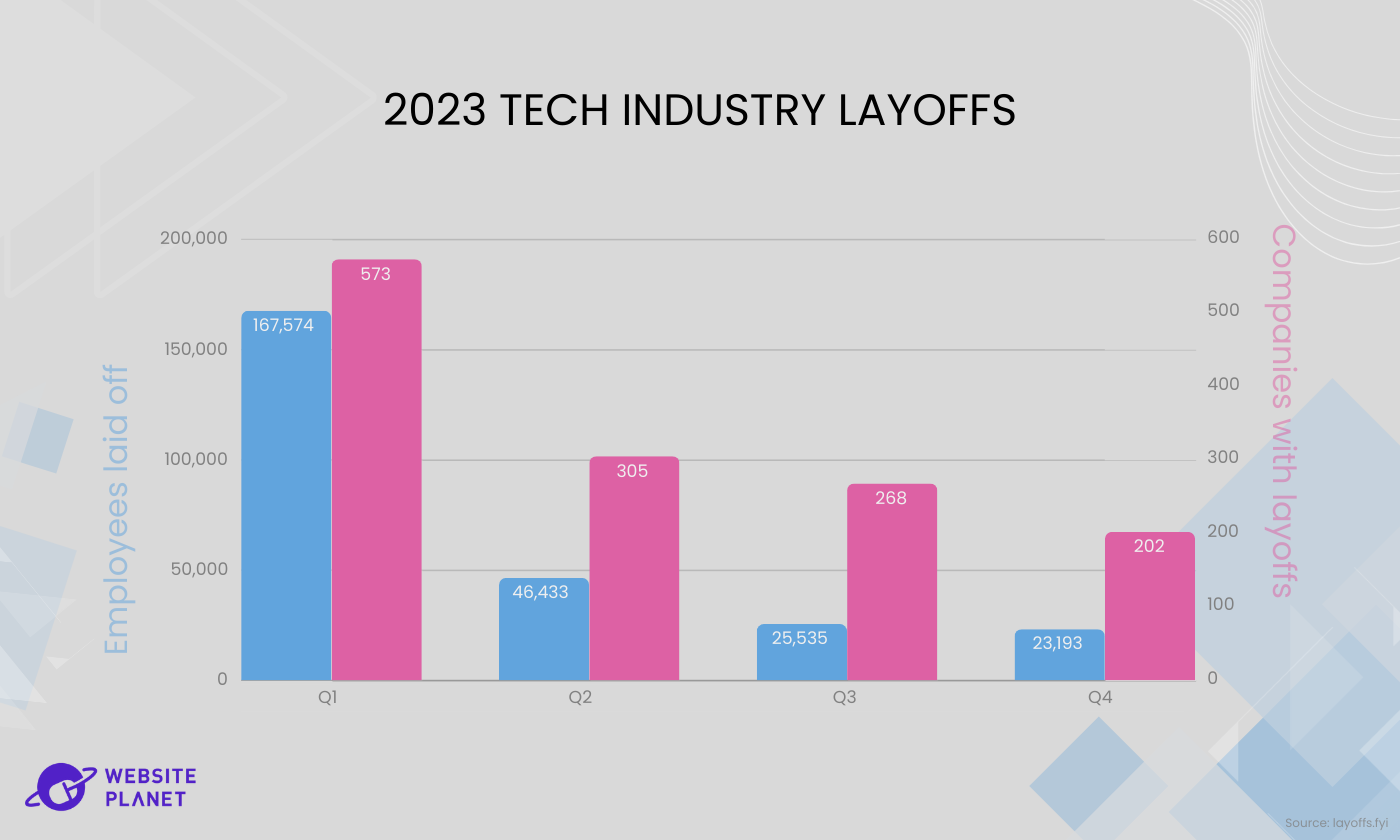 The numbers dropped considerably in Q2, as over 46,000 employees from nearly 310 companies were let go. This brings the total to more than 214,000 jobs lost in the first half of 2023 — a 374% year-over-year increase.
The numbers dropped considerably in Q2, as over 46,000 employees from nearly 310 companies were let go. This brings the total to more than 214,000 jobs lost in the first half of 2023 — a 374% year-over-year increase.
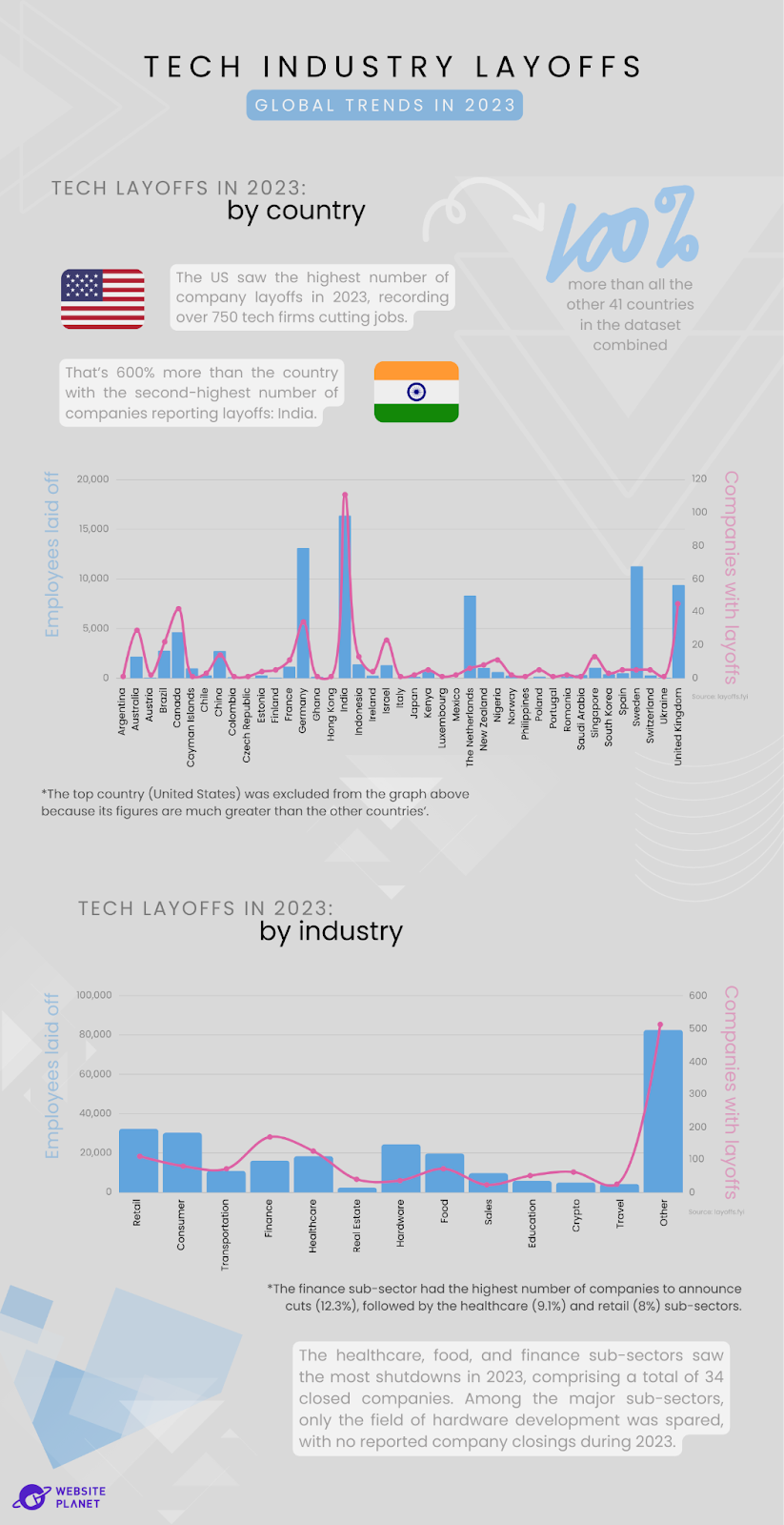
Biggest-Impact Tech Layoffs in 2023
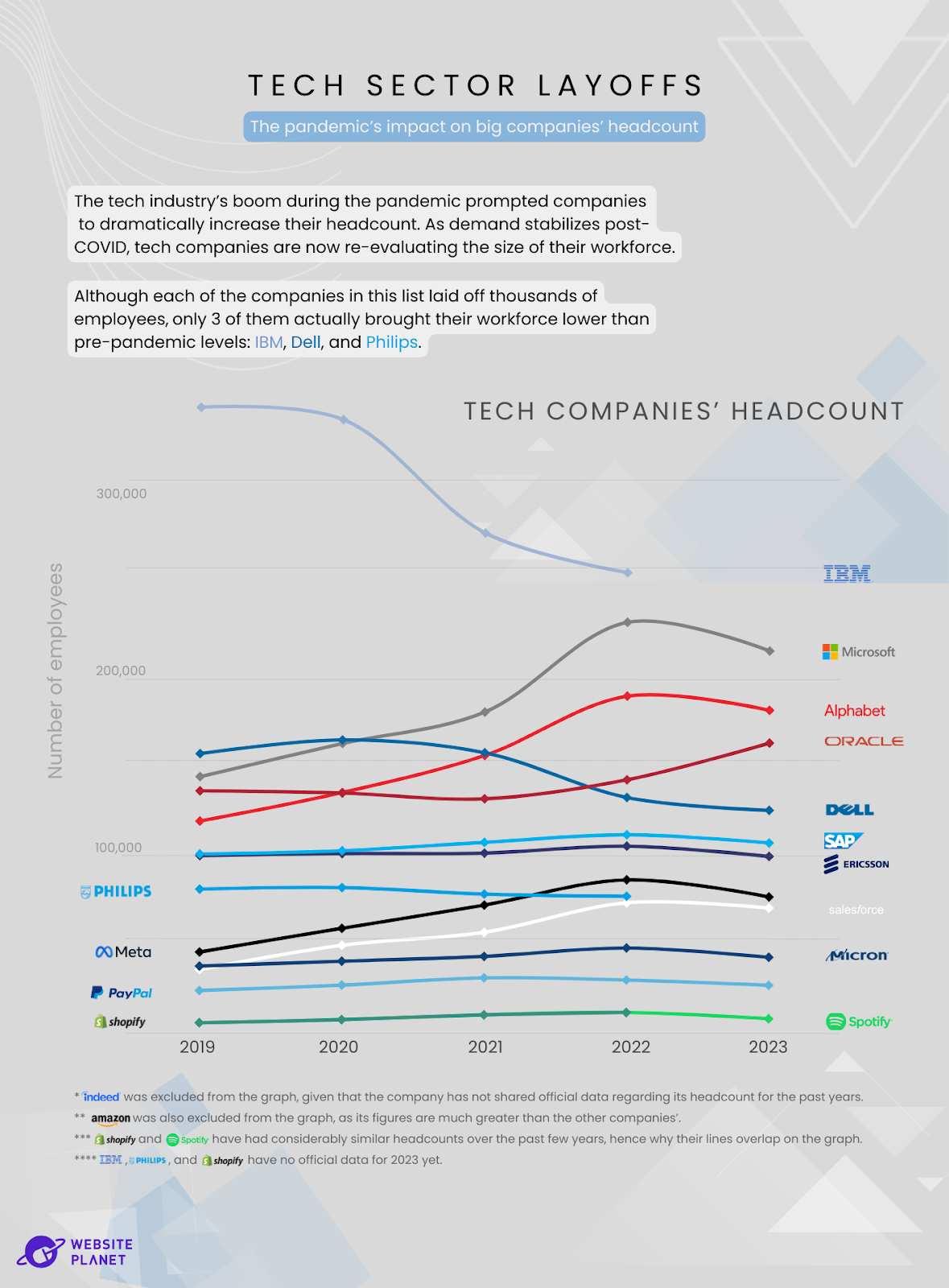

1. Amazon: 28,000 Employees (2% of Workforce)
 Tech giant Amazon greeted 2023 by announcing the impending layoff of over 18,000 employees in the stores and human resources departments. This is a significant increase from the originally published plan of cutting 10,000 jobs in its recruiting and devices divisions, reported in November 2022. It was anticipated to be the company’s biggest staff reduction in its nearly 29-year history.
However, Amazon made an even bigger splash in March 2023 when CEO Andy Jassy released a memo to staff disclosing another bout of layoffs that likely affected 9,000 more employees — bringing Amazon’s staff cuts to 27,000 during the first half of 2023. This round focused on the cloud computing, human resources, Twitch, and advertising units.
In the memo Jassy released, the pandemic hiring spree and mellowing business growth were cited as some of the top reasons for the layoffs. During the pandemic, Amazon’s staff doubled as the tech leader adapted to the increased demand for online services. By the close of 2021, the company’s worldwide staff had surged to over 1.6 million, a substantial increase from the 798,000 employees it had in the final quarter of 2019.
However, the downturn in tech reliance over 2023, coupled with the slowing of the retail business, reportedly pushed the company to make broad expense adjustments.
A few smaller cuts were announced later in 2023. Between April and July, Amazon reportedly fired nearly 700 employees. The cuts affected various divisions, including human resources, support, Amazon Web Services (AWS), Amazon Pharmacy, Amazon Studios, and the Prime Video unit.
In the last quarter of 2023, the company made more consecutive reductions. October saw a layoff of around 5% of employees in the communications departments, including Prime Video, Amazon Studios, and Amazon Music. In November, “several hundred” were let go in more divisions, such as Amazon Games and the Alexa unit. Company representatives did not disclose the exact number of people affected, but the reduction reportedly affected employees in North America, Latin America, Europe, and India.
In total, Amazon laid off approximately 28,000 employees in 2023.
On top of the announced employee cuts, reports surfaced toward the end of 2023 of Amazon allegedly trying to “encourage” workers to quit to avoid paying severance charges and dodge negative press from more layoff announcements. The company was supposedly eliminating positions without firing employees, leaving them on the payroll but urging them to find other roles within the company.
Most of the available roles were reportedly of lower title, lower pay, or office-based — in other words, the company made it unappealing to stay so that workers would choose to leave without severance benefits. Assuming this strategy worked, Amazon may have forsaken more than just 28,000 employees in 2023, although there are no official reports showing how many people found themselves in this position.
Tech giant Amazon greeted 2023 by announcing the impending layoff of over 18,000 employees in the stores and human resources departments. This is a significant increase from the originally published plan of cutting 10,000 jobs in its recruiting and devices divisions, reported in November 2022. It was anticipated to be the company’s biggest staff reduction in its nearly 29-year history.
However, Amazon made an even bigger splash in March 2023 when CEO Andy Jassy released a memo to staff disclosing another bout of layoffs that likely affected 9,000 more employees — bringing Amazon’s staff cuts to 27,000 during the first half of 2023. This round focused on the cloud computing, human resources, Twitch, and advertising units.
In the memo Jassy released, the pandemic hiring spree and mellowing business growth were cited as some of the top reasons for the layoffs. During the pandemic, Amazon’s staff doubled as the tech leader adapted to the increased demand for online services. By the close of 2021, the company’s worldwide staff had surged to over 1.6 million, a substantial increase from the 798,000 employees it had in the final quarter of 2019.
However, the downturn in tech reliance over 2023, coupled with the slowing of the retail business, reportedly pushed the company to make broad expense adjustments.
A few smaller cuts were announced later in 2023. Between April and July, Amazon reportedly fired nearly 700 employees. The cuts affected various divisions, including human resources, support, Amazon Web Services (AWS), Amazon Pharmacy, Amazon Studios, and the Prime Video unit.
In the last quarter of 2023, the company made more consecutive reductions. October saw a layoff of around 5% of employees in the communications departments, including Prime Video, Amazon Studios, and Amazon Music. In November, “several hundred” were let go in more divisions, such as Amazon Games and the Alexa unit. Company representatives did not disclose the exact number of people affected, but the reduction reportedly affected employees in North America, Latin America, Europe, and India.
In total, Amazon laid off approximately 28,000 employees in 2023.
On top of the announced employee cuts, reports surfaced toward the end of 2023 of Amazon allegedly trying to “encourage” workers to quit to avoid paying severance charges and dodge negative press from more layoff announcements. The company was supposedly eliminating positions without firing employees, leaving them on the payroll but urging them to find other roles within the company.
Most of the available roles were reportedly of lower title, lower pay, or office-based — in other words, the company made it unappealing to stay so that workers would choose to leave without severance benefits. Assuming this strategy worked, Amazon may have forsaken more than just 28,000 employees in 2023, although there are no official reports showing how many people found themselves in this position.
2. Microsoft: 16,000 Employees (7% of Workforce)
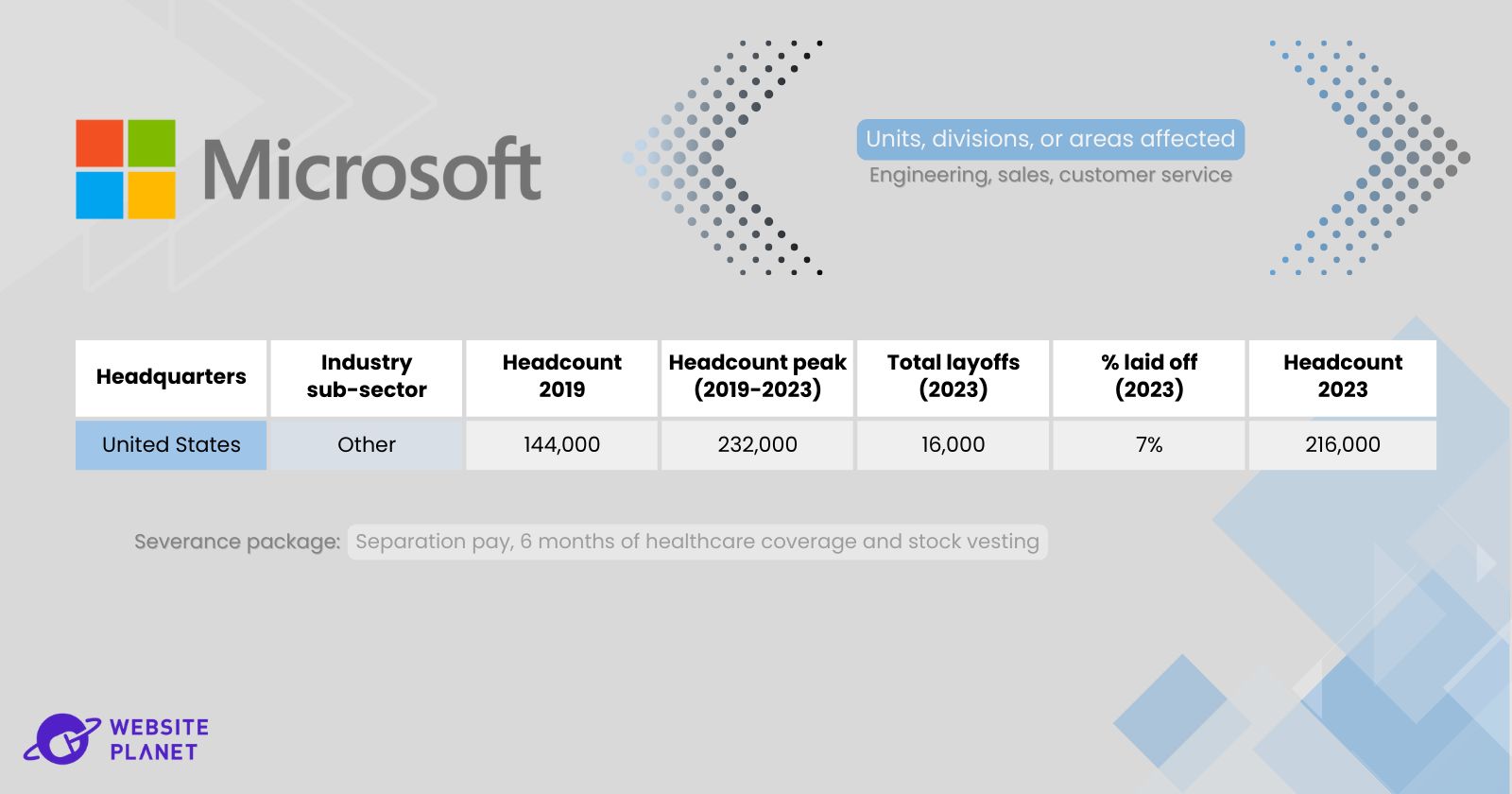 Around 5% of Microsoft’s workforce was announced to be impacted by layoffs in 2023, with the company’s engineering division being likely the most affected. This 10,000-staff layoff was announced back in January 2023 — just three months after the tech powerhouse confirmed it had already laid off 1,000 employees.
Not unlike the reasoning of the other big tech companies enforcing mass layoffs, CEO Satya Nadella pointed to shifting market behavior as the number one driver for the workforce reduction. According to him, consumers are optimizing their digital participation and spending as the world recovers from the pandemic’s isolation, resulting in a business slowdown for tech companies. What’s different with Microsoft is that while there is a drastic cutback in existing positions, Nadella clarified that the company will continue to hire in strategic divisions.
In June 2023, Microsoft reported having 221,000 employees globally — 11,000 fewer than its December 2022 declaration. This closely corresponds to the company’s January layoff announcement. However, layoffs did not stop there.
Microsoft announced another round of cuts in July 2023, although it opted not to disclose how many employees were to be affected. Only the number of people to be laid off in Washington was disclosed in a notice the company filed in the state — 276 employees, 66 of whom were working virtually. This workforce reduction focused on the sales and customer service divisions.
While Microsoft initially announced a 5% reduction in its workforce, its Securities and Exchange Commission (SEC) filing in September 2023 reported that the company’s headcount is down by 7% versus the previous year. This would put the total employee layoff count up to 16,000 instead of the initially declared 10,000.
Around 5% of Microsoft’s workforce was announced to be impacted by layoffs in 2023, with the company’s engineering division being likely the most affected. This 10,000-staff layoff was announced back in January 2023 — just three months after the tech powerhouse confirmed it had already laid off 1,000 employees.
Not unlike the reasoning of the other big tech companies enforcing mass layoffs, CEO Satya Nadella pointed to shifting market behavior as the number one driver for the workforce reduction. According to him, consumers are optimizing their digital participation and spending as the world recovers from the pandemic’s isolation, resulting in a business slowdown for tech companies. What’s different with Microsoft is that while there is a drastic cutback in existing positions, Nadella clarified that the company will continue to hire in strategic divisions.
In June 2023, Microsoft reported having 221,000 employees globally — 11,000 fewer than its December 2022 declaration. This closely corresponds to the company’s January layoff announcement. However, layoffs did not stop there.
Microsoft announced another round of cuts in July 2023, although it opted not to disclose how many employees were to be affected. Only the number of people to be laid off in Washington was disclosed in a notice the company filed in the state — 276 employees, 66 of whom were working virtually. This workforce reduction focused on the sales and customer service divisions.
While Microsoft initially announced a 5% reduction in its workforce, its Securities and Exchange Commission (SEC) filing in September 2023 reported that the company’s headcount is down by 7% versus the previous year. This would put the total employee layoff count up to 16,000 instead of the initially declared 10,000.
3. Meta: 10,000 Employees (12% of Workforce)
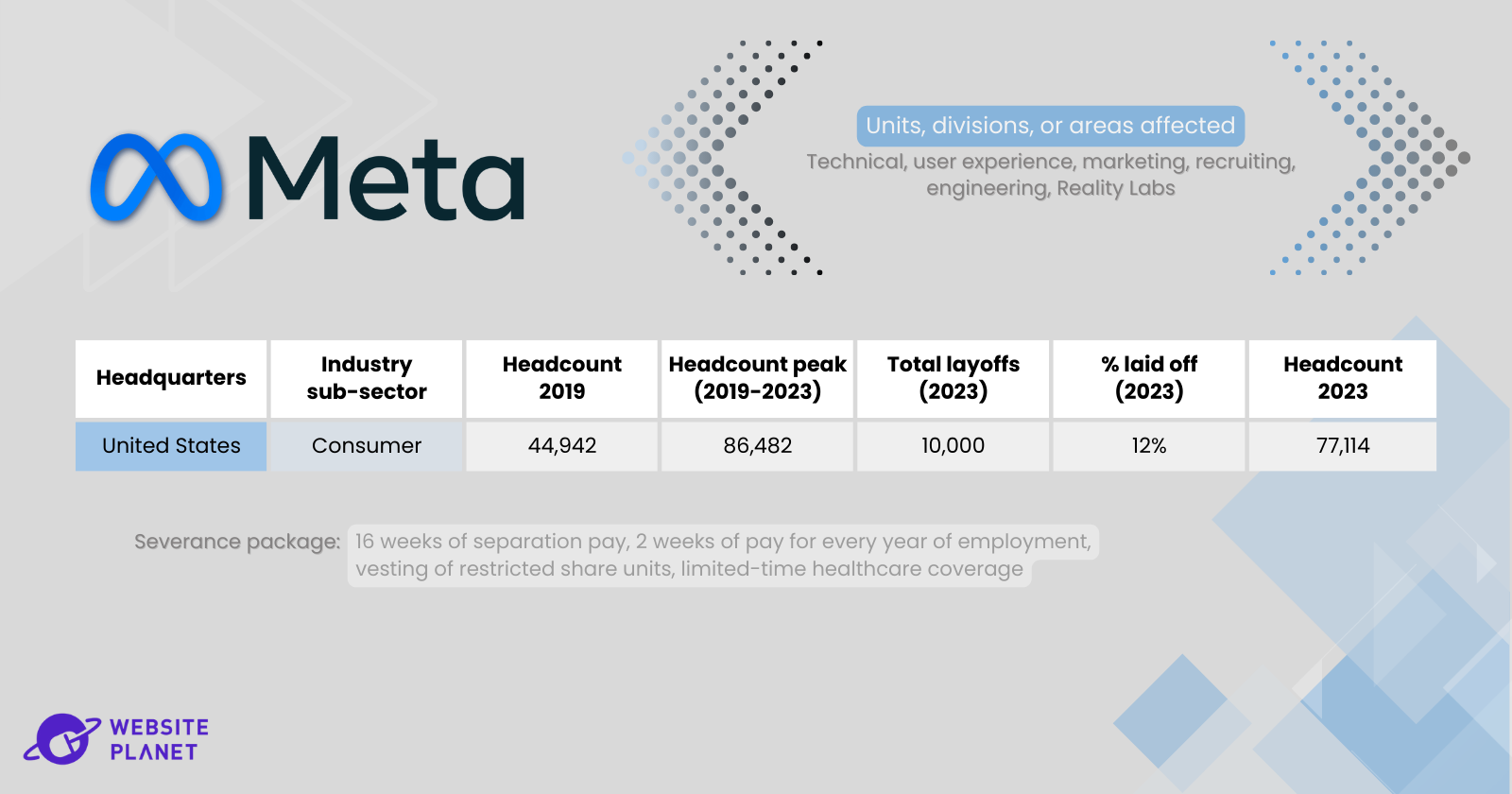 After declaring plans to eliminate 13% of its workforce in 2022, Meta doubled down on its planned “Year of Efficiency” by announcing an additional 10,000 job cuts for 2023. In total, the company planned to reduce about 25% of its 2022 workforce by 2023.
In an update shared on Meta’s newsroom page in March 2023, CEO Mark Zuckerberg reportedly informed Meta staff that 5,000 open roles without successful hires would also be closed soon. This was accompanied by a disclosure that low-priority projects would soon be shut down.
In the same letter, Zuckerberg said that the steps laid out are to achieve Meta’s primary goals of becoming “a better technology company” and improving its “financial performance in a difficult environment.”
The 10,000-employee reduction was executed in two stages. The first round started in April and focused on roles in technical divisions. Another round in May targeted workers in the company’s business groups, including recruiting, marketing, and user experience.
Amid the April-May cuts, Meta continued to invest in its metaverse unit, Reality Labs. However, another round of layoffs in October 2023 reportedly affected employees in the company’s Reality Labs’ custom silicon creation unit — Facebook Agile Silicon Team (FAST) — which housed around 600 workers. The layoff numbers were not disclosed, but the restructuring was said to be expected since Meta chose a new executive to head the division.
Later in October, Meta announced its plans to catch up on its “hiring backlog” by creating a workforce with more “higher-cost technical roles.” The company predicted higher hiring-related spending in 2024 to focus on its “priority areas.”
After declaring plans to eliminate 13% of its workforce in 2022, Meta doubled down on its planned “Year of Efficiency” by announcing an additional 10,000 job cuts for 2023. In total, the company planned to reduce about 25% of its 2022 workforce by 2023.
In an update shared on Meta’s newsroom page in March 2023, CEO Mark Zuckerberg reportedly informed Meta staff that 5,000 open roles without successful hires would also be closed soon. This was accompanied by a disclosure that low-priority projects would soon be shut down.
In the same letter, Zuckerberg said that the steps laid out are to achieve Meta’s primary goals of becoming “a better technology company” and improving its “financial performance in a difficult environment.”
The 10,000-employee reduction was executed in two stages. The first round started in April and focused on roles in technical divisions. Another round in May targeted workers in the company’s business groups, including recruiting, marketing, and user experience.
Amid the April-May cuts, Meta continued to invest in its metaverse unit, Reality Labs. However, another round of layoffs in October 2023 reportedly affected employees in the company’s Reality Labs’ custom silicon creation unit — Facebook Agile Silicon Team (FAST) — which housed around 600 workers. The layoff numbers were not disclosed, but the restructuring was said to be expected since Meta chose a new executive to head the division.
Later in October, Meta announced its plans to catch up on its “hiring backlog” by creating a workforce with more “higher-cost technical roles.” The company predicted higher hiring-related spending in 2024 to focus on its “priority areas.”
4. Ericsson: 8,500 Employees (8% of Workforce)
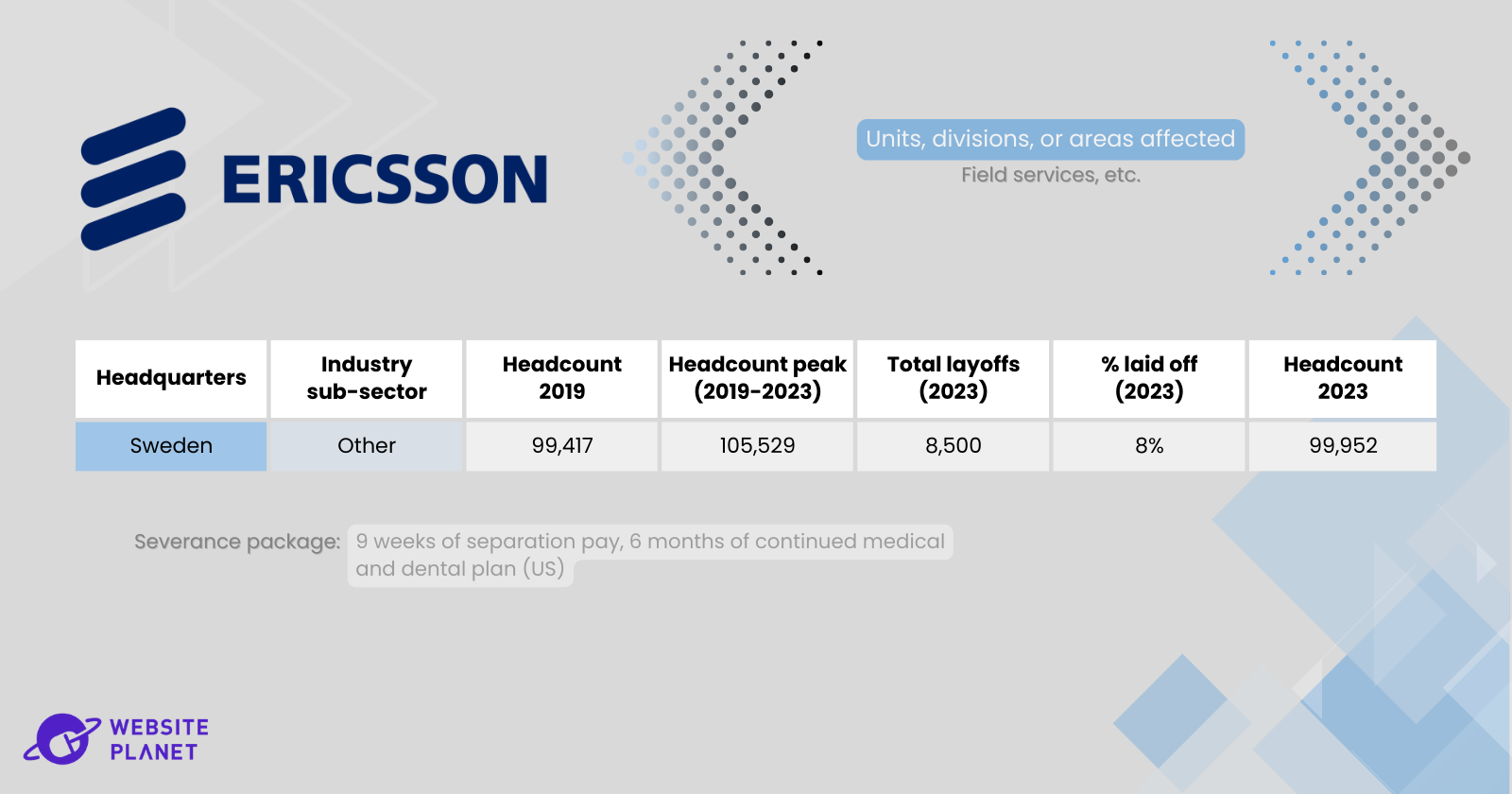 Ericsson’s 105,000-strong worldwide staff was set to go down by at least 8,500 employees (8% of its workforce) in 2023. This follows the company’s earlier plans to cut costs by up to USD 880 million by the last quarter of 2023 by paring down on real estate, consultants, and employees.
Reportedly, Ericsson’s terminations started across the globe in February 2023 and were likely to continue into 2024. According to Borje Ekholm, Ericsson’s Chief Executive, the layoffs would be handled differently per region. The first region to announce job cuts was Sweden, where 1,400 employees were affected.
In July 2023, the company’s People Operations Team sent out a memo explaining that field services in Ericsson’s US arm were to be transitioned to “external providers,” and 750 employees in North America were to expect a separation date of September 29, 2023. This number constituted almost 7% of the company’s workforce in North America.
Ericsson’s 105,000-strong worldwide staff was set to go down by at least 8,500 employees (8% of its workforce) in 2023. This follows the company’s earlier plans to cut costs by up to USD 880 million by the last quarter of 2023 by paring down on real estate, consultants, and employees.
Reportedly, Ericsson’s terminations started across the globe in February 2023 and were likely to continue into 2024. According to Borje Ekholm, Ericsson’s Chief Executive, the layoffs would be handled differently per region. The first region to announce job cuts was Sweden, where 1,400 employees were affected.
In July 2023, the company’s People Operations Team sent out a memo explaining that field services in Ericsson’s US arm were to be transitioned to “external providers,” and 750 employees in North America were to expect a separation date of September 29, 2023. This number constituted almost 7% of the company’s workforce in North America.
5. Salesforce: 8,000 Employees (10% of Workforce)
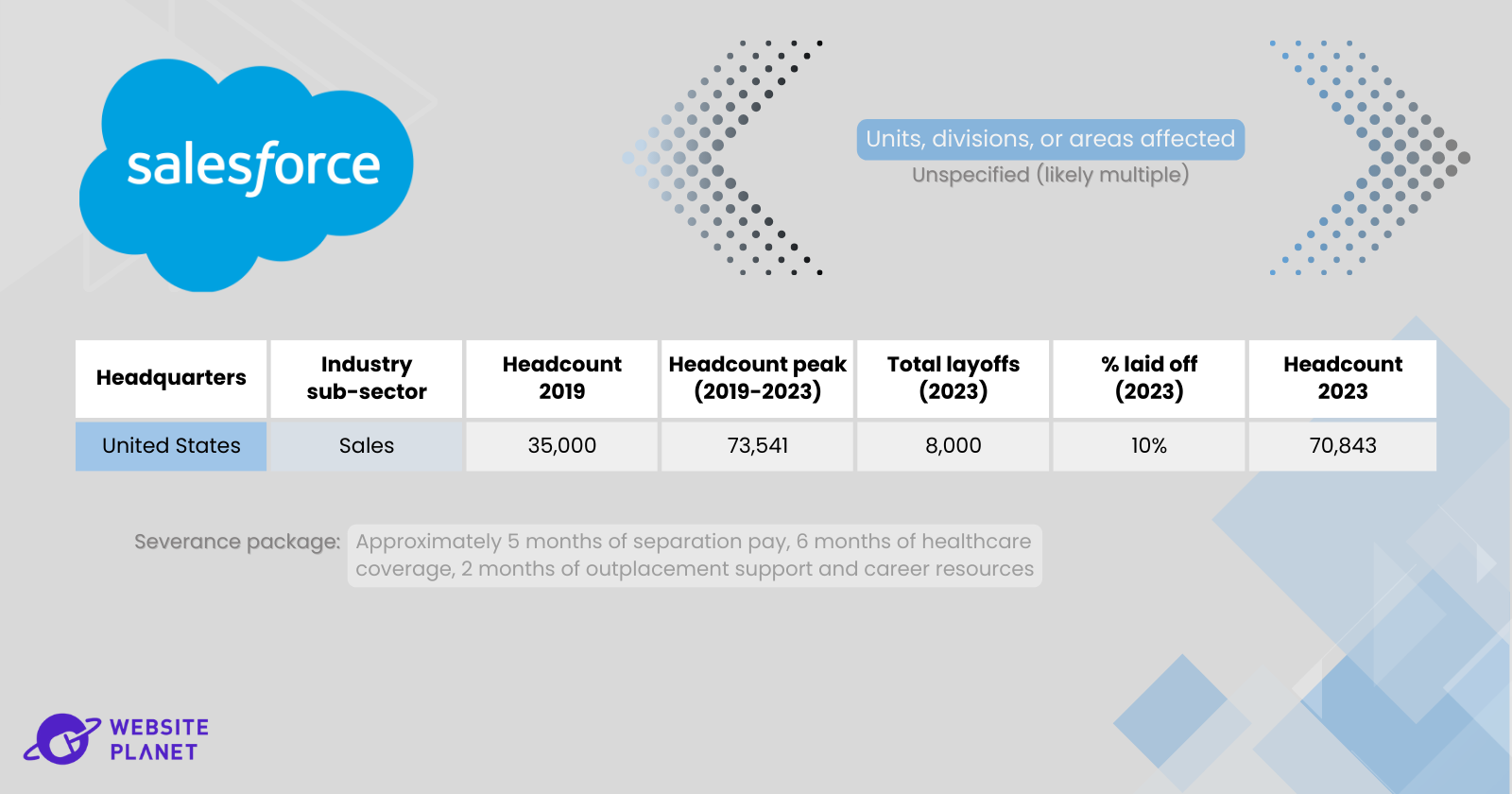 Another 8,000 employees in the e-commerce and sales sub-sectors were set to lose their jobs as Salesforce closed down some of its offices and announced plans to lay off 10% of its workforce. In January 2023, CEO Marc Benioff addressed Salesforce employees in a memo explaining that the overhiring during the pandemic revenue boost made the looming mass firing inevitable.
Salesforce reported slowing growth in 2022. However, shares rose by 3% after it disclosed the layoffs.
In September 2023, Salesforce announced that it is set to rehire 3,300 people in an effort to “grow the company,” thus restoring 41% of the positions that were cut. In a statement during Salesforce’s annual conference, Benioff explained that they were looking to “boomerang” employees — those who previously worked at the company — to fill the open positions. The rehiring was said to focus on engineering, sales, and the company’s data cloud product.
Another 8,000 employees in the e-commerce and sales sub-sectors were set to lose their jobs as Salesforce closed down some of its offices and announced plans to lay off 10% of its workforce. In January 2023, CEO Marc Benioff addressed Salesforce employees in a memo explaining that the overhiring during the pandemic revenue boost made the looming mass firing inevitable.
Salesforce reported slowing growth in 2022. However, shares rose by 3% after it disclosed the layoffs.
In September 2023, Salesforce announced that it is set to rehire 3,300 people in an effort to “grow the company,” thus restoring 41% of the positions that were cut. In a statement during Salesforce’s annual conference, Benioff explained that they were looking to “boomerang” employees — those who previously worked at the company — to fill the open positions. The rehiring was said to focus on engineering, sales, and the company’s data cloud product.
6. Alphabet: 8,000 Employees (4% of Workforce)
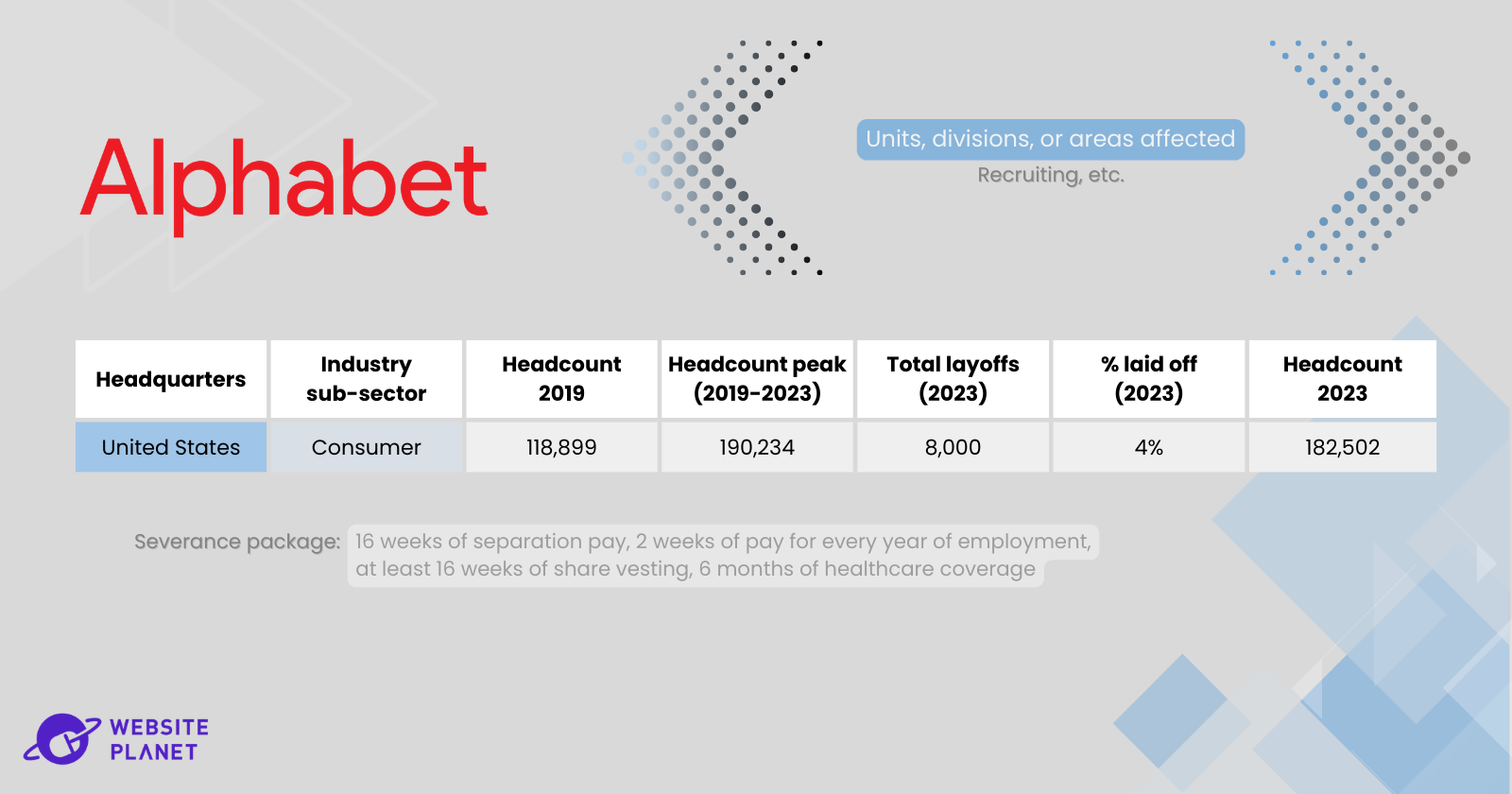 Employees of Alphabet, the conglomerate behind Google, also faced the consequences of the company’s overhiring during the pandemic. After welcoming over 50,000 new staff from 2020 to 2022, the company announced in early 2023 that it would cull its workforce by 12,000. The previous workforce growth was attributed to the market’s heightened dependence on tech during the COVID-19 pandemic.
Advertisers are reportedly curbing their spending due to fears of recession, greatly impacting Alphabet’s ad business. CEO Sundar Pichai mentioned the company’s intent to refocus on this core business as part of the reason behind the layoffs. He also noted plans to invest early in artificial intelligence (AI) and drastically reduce experimental project expenditures.
Pichai talked of facing a “different economic reality” after the pandemic. If it is any silver lining, laid-off US employees were guaranteed a severance equivalent to at least 16 weeks’ salary and remained on the company’s payroll for 60 days after their termination notice.
In September 2023, Alphabet let go of “a few hundred” employees, this time in its global recruiting division. However, the company clarified that most of the department was to be retained for essential hiring roles. Alphabet also said that it would help the laid-off employees to find positions in other divisions or companies.
On December 31, 2023, Alphabet reported a total headcount of 182,502 and said that it had finished its rounds of workforce reduction. Based on the company’s declared employee count in December 2022, it only let go of 7,732 people in 2023 instead of the predicted 12,000.
Employees of Alphabet, the conglomerate behind Google, also faced the consequences of the company’s overhiring during the pandemic. After welcoming over 50,000 new staff from 2020 to 2022, the company announced in early 2023 that it would cull its workforce by 12,000. The previous workforce growth was attributed to the market’s heightened dependence on tech during the COVID-19 pandemic.
Advertisers are reportedly curbing their spending due to fears of recession, greatly impacting Alphabet’s ad business. CEO Sundar Pichai mentioned the company’s intent to refocus on this core business as part of the reason behind the layoffs. He also noted plans to invest early in artificial intelligence (AI) and drastically reduce experimental project expenditures.
Pichai talked of facing a “different economic reality” after the pandemic. If it is any silver lining, laid-off US employees were guaranteed a severance equivalent to at least 16 weeks’ salary and remained on the company’s payroll for 60 days after their termination notice.
In September 2023, Alphabet let go of “a few hundred” employees, this time in its global recruiting division. However, the company clarified that most of the department was to be retained for essential hiring roles. Alphabet also said that it would help the laid-off employees to find positions in other divisions or companies.
On December 31, 2023, Alphabet reported a total headcount of 182,502 and said that it had finished its rounds of workforce reduction. Based on the company’s declared employee count in December 2022, it only let go of 7,732 people in 2023 instead of the predicted 12,000.
7. Micron: 7,200 Employees (15% of Workforce)
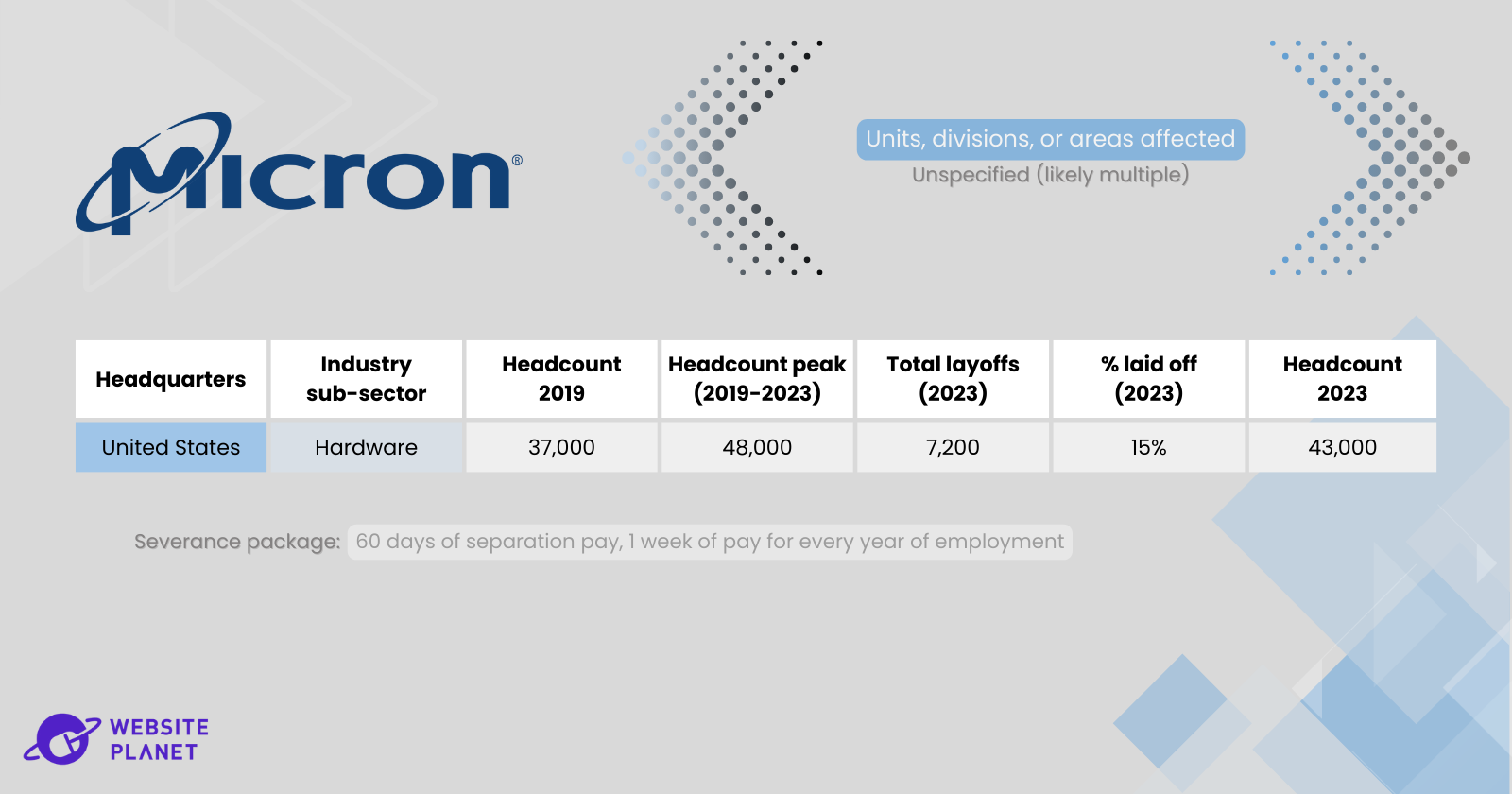 After confirming a planned 10% workforce reduction in January 2023, Micron doubled down with another layoff announcement in February 2023, bringing the total terminations up to 7,200. The Boise-based semiconductor company had around 48,000 employees in North America, Asia, and Europe in 2022, which means Micron set out to lose 15% of its workforce.
After the pandemic supply boost and the subsequent drop in chip demand, the company reportedly faced bleak market outlooks. Micron public relations manager Tate Tran corresponded with television news station KTVB and said that the layoffs are aligned with other cost-cutting plans, such as capital expenditures reduction, companywide bonus suspensions, and executive salary cuts.
In the first quarter of 2024, however, Micron saw skyrocketing shares. The company reportedly witnessed a 40% increase in orders for AI-optimized servers. It also noted a rising interest in next-generation AI GPUs, where the “demand continues to outpace [the] supply.”
After confirming a planned 10% workforce reduction in January 2023, Micron doubled down with another layoff announcement in February 2023, bringing the total terminations up to 7,200. The Boise-based semiconductor company had around 48,000 employees in North America, Asia, and Europe in 2022, which means Micron set out to lose 15% of its workforce.
After the pandemic supply boost and the subsequent drop in chip demand, the company reportedly faced bleak market outlooks. Micron public relations manager Tate Tran corresponded with television news station KTVB and said that the layoffs are aligned with other cost-cutting plans, such as capital expenditures reduction, companywide bonus suspensions, and executive salary cuts.
In the first quarter of 2024, however, Micron saw skyrocketing shares. The company reportedly witnessed a 40% increase in orders for AI-optimized servers. It also noted a rising interest in next-generation AI GPUs, where the “demand continues to outpace [the] supply.”
8. Dell: 6,650 Employees (5% of Workforce)
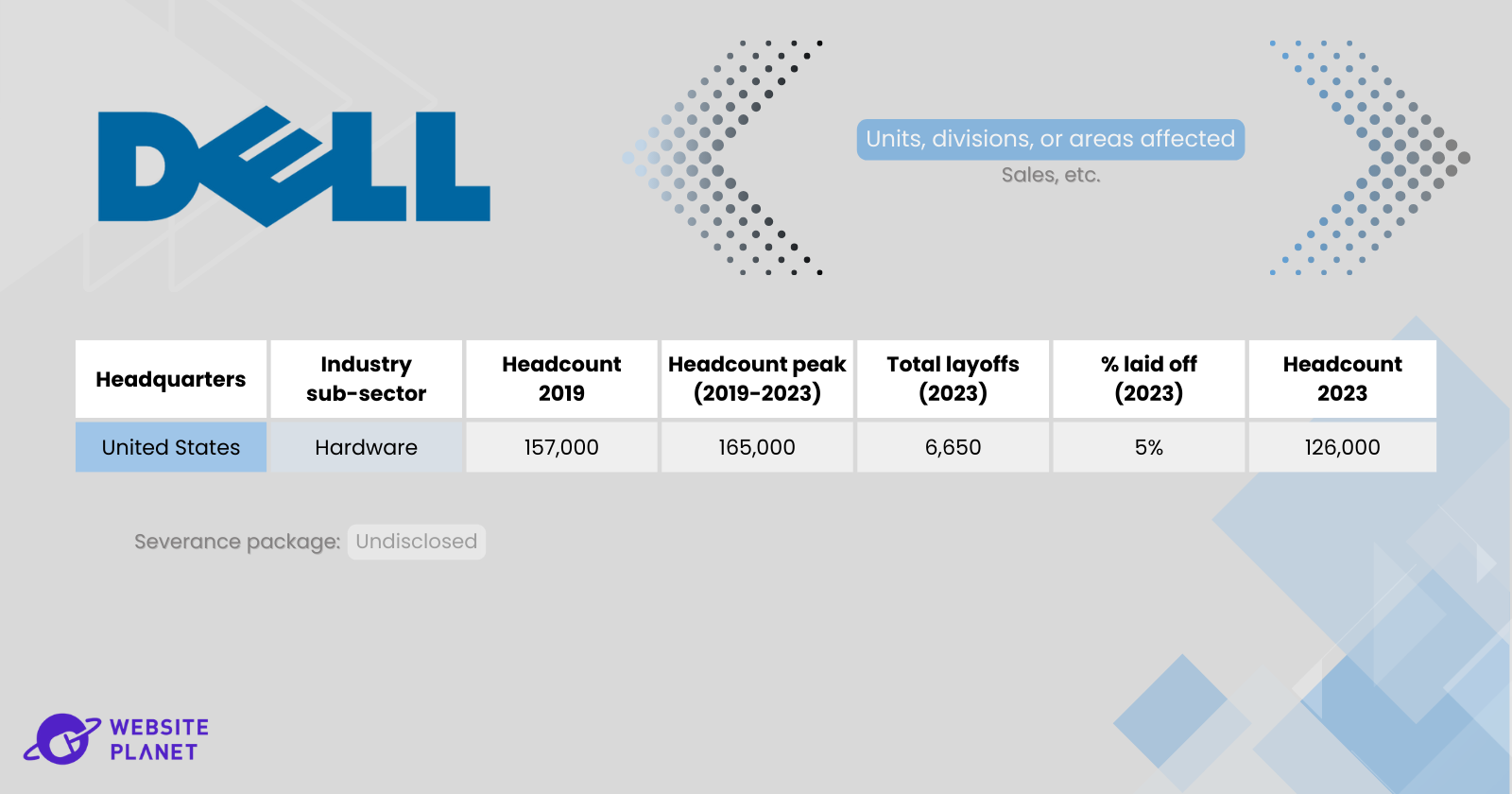 Dell, a leading American-based computer and tech developer and producer, announced in February 2023 its plans to decrease its workforce to the lowest headcount in six years. Approximately 5% of the company’s workforce, or 6,650 employees, were set to be laid off in response to plummeting personal computer sales.
The tech giant, for whom 55% of revenue comes from PC sales, suffered a 37% YoY drop in PC orders in Q2 of 2022. The slowing PC market continued to affect Dell through 2023, reporting a Q3 revenue that fell short of projections. The company’s revenue in that quarter was 11% lower than in Q3 of 2022.
While Dell has previously implemented cost regulation strategies, including hiring freezes and travel limitations, Co-COO Jeff Clarke stated those measures had not been enough for the company to adapt to market conditions.
In August 2023, the company announced a shift in its market approach that entailed the layoff of members of its sales teams. Dell did not provide the number of employees to be fired, nor did it clarify whether these job cuts were part of the 6,650-employee reduction.
Dell, a leading American-based computer and tech developer and producer, announced in February 2023 its plans to decrease its workforce to the lowest headcount in six years. Approximately 5% of the company’s workforce, or 6,650 employees, were set to be laid off in response to plummeting personal computer sales.
The tech giant, for whom 55% of revenue comes from PC sales, suffered a 37% YoY drop in PC orders in Q2 of 2022. The slowing PC market continued to affect Dell through 2023, reporting a Q3 revenue that fell short of projections. The company’s revenue in that quarter was 11% lower than in Q3 of 2022.
While Dell has previously implemented cost regulation strategies, including hiring freezes and travel limitations, Co-COO Jeff Clarke stated those measures had not been enough for the company to adapt to market conditions.
In August 2023, the company announced a shift in its market approach that entailed the layoff of members of its sales teams. Dell did not provide the number of employees to be fired, nor did it clarify whether these job cuts were part of the 6,650-employee reduction.
9. Philips: 6,000 Employees (8% of Workforce)
 Following its first round of workforce reductions in October 2022, which affected 4,000 employees, Philips announced the layoff of another 6,000 workers in January 2023. The company claimed the cuts were part of its goal to drive profitability and enhance product safety.
Reportedly, 3,000 employees were let go in 2023, while the other half of the layoffs will be carried out in 2024 and 2025. In total, Philips’ workforce will drop by 13% compared to its 2021 headcount.
Philips’s current Chief Executive Roy Jakobs said the job cuts align with the company’s plan to focus on “fewer, better resourced, and more impactful projects” to recover from losses. In 2021, the Dutch health-tech company lost 70% market value after recalling millions of respiratory devices due to “potential health risks.”
Following its first round of workforce reductions in October 2022, which affected 4,000 employees, Philips announced the layoff of another 6,000 workers in January 2023. The company claimed the cuts were part of its goal to drive profitability and enhance product safety.
Reportedly, 3,000 employees were let go in 2023, while the other half of the layoffs will be carried out in 2024 and 2025. In total, Philips’ workforce will drop by 13% compared to its 2021 headcount.
Philips’s current Chief Executive Roy Jakobs said the job cuts align with the company’s plan to focus on “fewer, better resourced, and more impactful projects” to recover from losses. In 2021, the Dutch health-tech company lost 70% market value after recalling millions of respiratory devices due to “potential health risks.”
10. IBM: 3,900 Employees (1.5% of Workforce)
 As it moves to leverage the AI and cloud-computing market, multinational tech corp IBM announced in January 2023 that it would remove 3,900 employees from its payroll, eliminating about 1.5% of its workforce. According to IBM’s CFO James Kavanaugh, the layoff will affect workers in the Kyndryl and Watson Health divisions.
Despite the job cuts, Kavanaugh reiterates that the company will continue to hire for “client-facing research and development.” This is to bolster CEO Arvind Krishna’s move to transition Big Blue from its traditional infotech and consulting services to a hybrid cloud core business. Since 2021, the company has seen growth in its hybrid cloud revenue after a decade of plateaued sales.
In May 2023, Krishna said in an interview that the company plans to slow down or stop hiring for non-customer-facing roles, such as human resources. IBM has around 26,000 jobs that fall under this category, and Krishna said that 30% of those may be “replaced by AI and automation over a 5-year period.” In other words, around 7,800 employees may be laid off by 2028.
As it moves to leverage the AI and cloud-computing market, multinational tech corp IBM announced in January 2023 that it would remove 3,900 employees from its payroll, eliminating about 1.5% of its workforce. According to IBM’s CFO James Kavanaugh, the layoff will affect workers in the Kyndryl and Watson Health divisions.
Despite the job cuts, Kavanaugh reiterates that the company will continue to hire for “client-facing research and development.” This is to bolster CEO Arvind Krishna’s move to transition Big Blue from its traditional infotech and consulting services to a hybrid cloud core business. Since 2021, the company has seen growth in its hybrid cloud revenue after a decade of plateaued sales.
In May 2023, Krishna said in an interview that the company plans to slow down or stop hiring for non-customer-facing roles, such as human resources. IBM has around 26,000 jobs that fall under this category, and Krishna said that 30% of those may be “replaced by AI and automation over a 5-year period.” In other words, around 7,800 employees may be laid off by 2028.
11. SAP: 3,000 Employees (2.5% of Workforce)
 Multinational software business SAP is the first Germany-based company to make it into the list of the most notable tech layoffs in 2023. In January 2023, it confirmed a restructuring that eliminated 3,000 employees or 2.5% of its workforce. Over 200 jobs were affected in its home country.
In an interview, CEO Christian Klein cited a “targeted restructuring” as the main reason for the layoffs. He explained that the company is looking to “streamline [its] portfolio and concentrate investments” on its most profitable and impactful divisions. CFO Luka Mucic said they expect around EUR 300–350 million (USD 327–382 million) in savings from the layoffs.
The 3,000-employee reduction mainly targeted customer relationship management (CRM) roles as the company doubled down on its plans to refocus on its cloud business and supply chain and sustainability software offerings. In line with this, SAP was reportedly hiring for 1,000 open positions, prioritizing “young and early career talent.”
In December 2023, SAP reported an end-of-month headcount of 107,602, which is 3.9% lower than its 2022 workforce. However, no other rounds of layoff were confirmed. This suggests that the company may have terminated more employees than declared or conducted an unannounced workforce reduction. The final figure could also be a reflection of workers quitting.
Multinational software business SAP is the first Germany-based company to make it into the list of the most notable tech layoffs in 2023. In January 2023, it confirmed a restructuring that eliminated 3,000 employees or 2.5% of its workforce. Over 200 jobs were affected in its home country.
In an interview, CEO Christian Klein cited a “targeted restructuring” as the main reason for the layoffs. He explained that the company is looking to “streamline [its] portfolio and concentrate investments” on its most profitable and impactful divisions. CFO Luka Mucic said they expect around EUR 300–350 million (USD 327–382 million) in savings from the layoffs.
The 3,000-employee reduction mainly targeted customer relationship management (CRM) roles as the company doubled down on its plans to refocus on its cloud business and supply chain and sustainability software offerings. In line with this, SAP was reportedly hiring for 1,000 open positions, prioritizing “young and early career talent.”
In December 2023, SAP reported an end-of-month headcount of 107,602, which is 3.9% lower than its 2022 workforce. However, no other rounds of layoff were confirmed. This suggests that the company may have terminated more employees than declared or conducted an unannounced workforce reduction. The final figure could also be a reflection of workers quitting.
12. Oracle: 3,000 Employees (2% of Workforce)
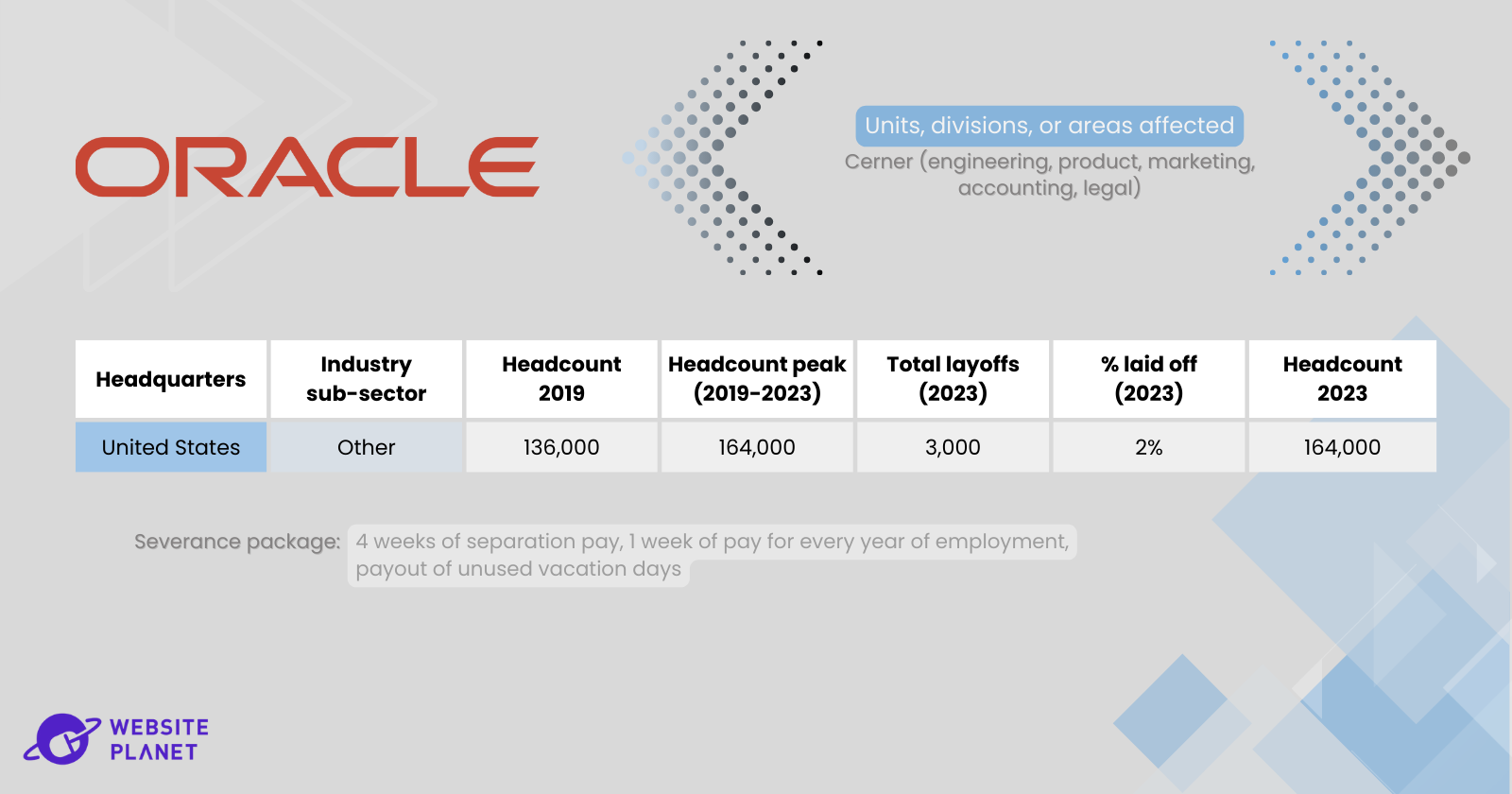 Cloud company Oracle laid off approximately 3,employees in early May 2023 as part of its cost-cutting efforts. The headcount reduction affected workers in the firm’s Cerner unit, an electronic healthcare record (EHR) tech giant that Oracle acquired in June 2022.
The acquisition of Cerner added around 28,000 employees to Oracle’s headcount, ~11% of whom were affected by the layoff. At the end of May 2023, Oracle still had 21,000 more employees than it did before acquiring Cerner.
However, the company made another round of cuts in the unit in June 2023, affecting “hundreds” more. Oracle also reportedly rescinded job offers and closed some open positions in its Cerner operation. Reports showed that the layoffs in Oracle’s EHR arm were primarily due to having less work, as its contract with the US Department of Veterans Affairs got renegotiated.
Despite eliminating over 3,000 jobs, Oracle’s 2023 yearly headcount was still at a record high, owing mainly to the company’s acquisition of Cerner in 2022. The company gained 32,000 employees in 2022 and 2023 combined, which shows that it continued expanding even amid the layoffs.
Cloud company Oracle laid off approximately 3,employees in early May 2023 as part of its cost-cutting efforts. The headcount reduction affected workers in the firm’s Cerner unit, an electronic healthcare record (EHR) tech giant that Oracle acquired in June 2022.
The acquisition of Cerner added around 28,000 employees to Oracle’s headcount, ~11% of whom were affected by the layoff. At the end of May 2023, Oracle still had 21,000 more employees than it did before acquiring Cerner.
However, the company made another round of cuts in the unit in June 2023, affecting “hundreds” more. Oracle also reportedly rescinded job offers and closed some open positions in its Cerner operation. Reports showed that the layoffs in Oracle’s EHR arm were primarily due to having less work, as its contract with the US Department of Veterans Affairs got renegotiated.
Despite eliminating over 3,000 jobs, Oracle’s 2023 yearly headcount was still at a record high, owing mainly to the company’s acquisition of Cerner in 2022. The company gained 32,000 employees in 2022 and 2023 combined, which shows that it continued expanding even amid the layoffs.
13. Spotify: 2,300 Employees (23% of Workforce)
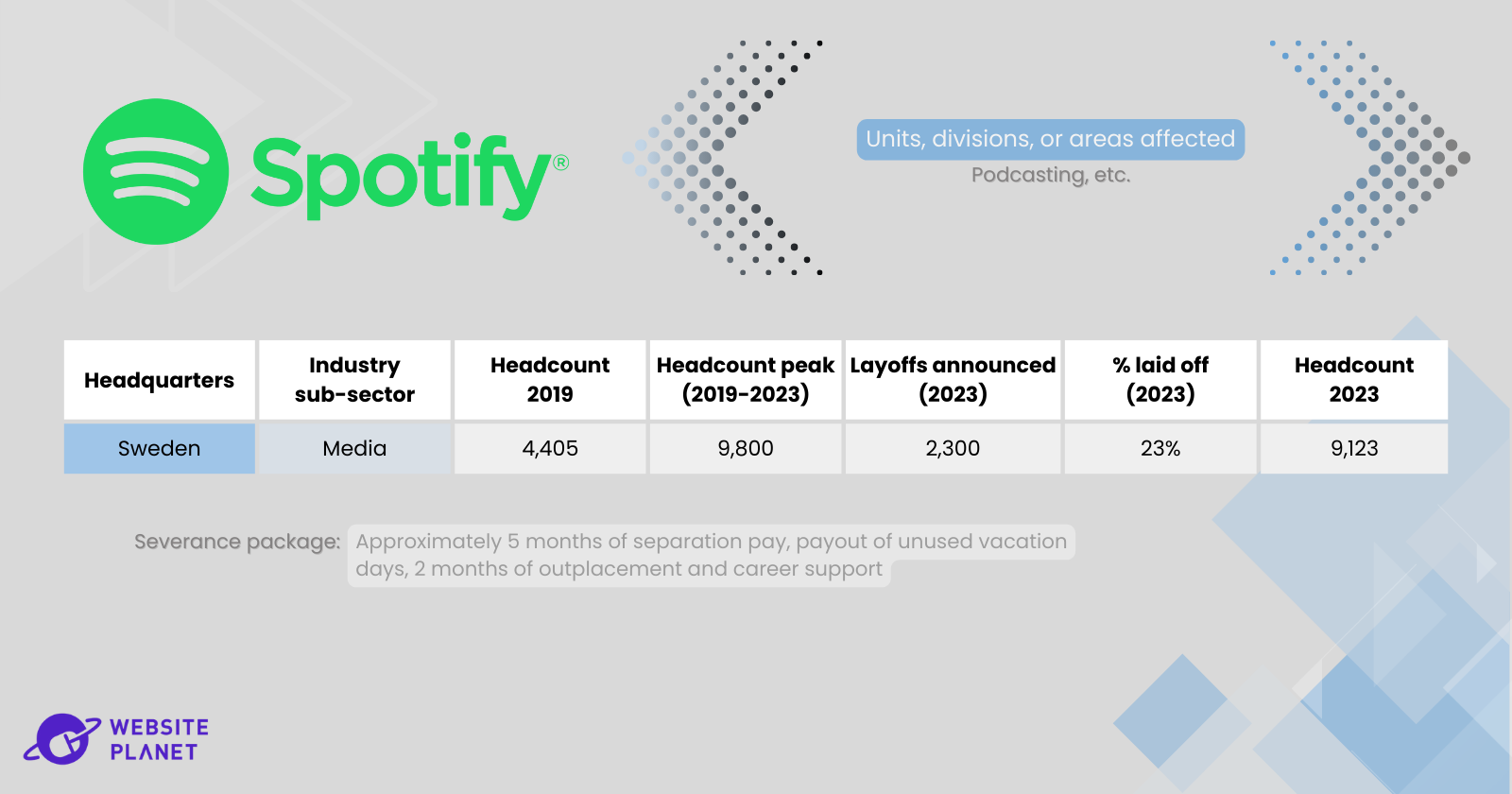 Digital music service Spotify announced in January 2023 its plans to cull its workforce by 600 to “drive more efficiency, control costs, and speed up decision-making.” The company did not disclose which teams or units would be affected but shared that it estimated USD 35-45 million in severance expenses.
In June 2023, Spotify doubled down with another 200 job cuts, this time focusing on its podcast division. According to a publicly shared memo to employees, this round of layoffs was a move to support the company’s pursuit of “optimal organization” as it moved to a more tailored process of partnering with podcast creators. This pursuit can be traced back to October 2022, when Spotify canceled 11 of its original podcasts.
Spotify’s final round of 2023 layoffs came in December. This one had a much larger scope, impacting 1,500 employees. Daniel Ek, Spotify’s co-founder and CEO, said that the company’s global operational costs were too big and “rightsizing” was the best way to achieve its financial goals. The announcement came after Spotify reported revenues that increased by 11% or USD 3.6 billion in Q3 of 2023.
In total, Spotify planned to cull its 2023 staff by 23% compared to its 2022 workforce. The media giant’s last reported headcount in 2023, however, suggests that the layoffs may continue into 2024.
Digital music service Spotify announced in January 2023 its plans to cull its workforce by 600 to “drive more efficiency, control costs, and speed up decision-making.” The company did not disclose which teams or units would be affected but shared that it estimated USD 35-45 million in severance expenses.
In June 2023, Spotify doubled down with another 200 job cuts, this time focusing on its podcast division. According to a publicly shared memo to employees, this round of layoffs was a move to support the company’s pursuit of “optimal organization” as it moved to a more tailored process of partnering with podcast creators. This pursuit can be traced back to October 2022, when Spotify canceled 11 of its original podcasts.
Spotify’s final round of 2023 layoffs came in December. This one had a much larger scope, impacting 1,500 employees. Daniel Ek, Spotify’s co-founder and CEO, said that the company’s global operational costs were too big and “rightsizing” was the best way to achieve its financial goals. The announcement came after Spotify reported revenues that increased by 11% or USD 3.6 billion in Q3 of 2023.
In total, Spotify planned to cull its 2023 staff by 23% compared to its 2022 workforce. The media giant’s last reported headcount in 2023, however, suggests that the layoffs may continue into 2024.
14. Shopify: 2,300 Employees (20% of Workforce)
 In May 2023, Shopify confirmed a 20% headcount reduction plan, with 2,300 employees on the chopping block. This was the e-commerce business’s second round of job cuts after a 10% reduction in July 2022, which affected 1,000 workers. According to CEO Tobi Lütke, the company miscalculated the longevity of e-commerce growth during the pandemic.
The announcement of the second round of job cuts came barely three months after Shopify president Harley Finkelstein declared that no more layoffs would happen in 2023. He explained that the company was likely to keep its headcount flat, hiring only for key roles.
Therefore, the large percentage of workforce reduction in May 2023 was unexpected by many in the industry, especially after Shopify reported Q1 2023 earnings that exceeded Wall Street’s projections, adding up to a 25% revenue increase from Q1 2022.
In May 2023, Shopify confirmed a 20% headcount reduction plan, with 2,300 employees on the chopping block. This was the e-commerce business’s second round of job cuts after a 10% reduction in July 2022, which affected 1,000 workers. According to CEO Tobi Lütke, the company miscalculated the longevity of e-commerce growth during the pandemic.
The announcement of the second round of job cuts came barely three months after Shopify president Harley Finkelstein declared that no more layoffs would happen in 2023. He explained that the company was likely to keep its headcount flat, hiring only for key roles.
Therefore, the large percentage of workforce reduction in May 2023 was unexpected by many in the industry, especially after Shopify reported Q1 2023 earnings that exceeded Wall Street’s projections, adding up to a 25% revenue increase from Q1 2022.
15. Indeed: 2,200 Employees (15% of Workforce)
 On March 22, 2023, Chris Hyams, CEO of employment and job search website Indeed, published a message for the company’s employees explaining an impending 15% workforce reduction. The cuts affected around 2,200 staff members “from nearly every team, function, level and region at Indeed and Indeed Flex.”
In the letter, Hyams shared that the cause behind the headcount reduction mainly involved the 3.5% YoY drop in total US job openings in the previous quarter and the forecast of continued job market decline. The company predicts that US job openings will fall back to pre-pandemic levels (7.5 million) and potentially drop further until 2026.
On March 22, 2023, Chris Hyams, CEO of employment and job search website Indeed, published a message for the company’s employees explaining an impending 15% workforce reduction. The cuts affected around 2,200 staff members “from nearly every team, function, level and region at Indeed and Indeed Flex.”
In the letter, Hyams shared that the cause behind the headcount reduction mainly involved the 3.5% YoY drop in total US job openings in the previous quarter and the forecast of continued job market decline. The company predicts that US job openings will fall back to pre-pandemic levels (7.5 million) and potentially drop further until 2026.
16. PayPal: 2,000 Employees (7% of Workforce)
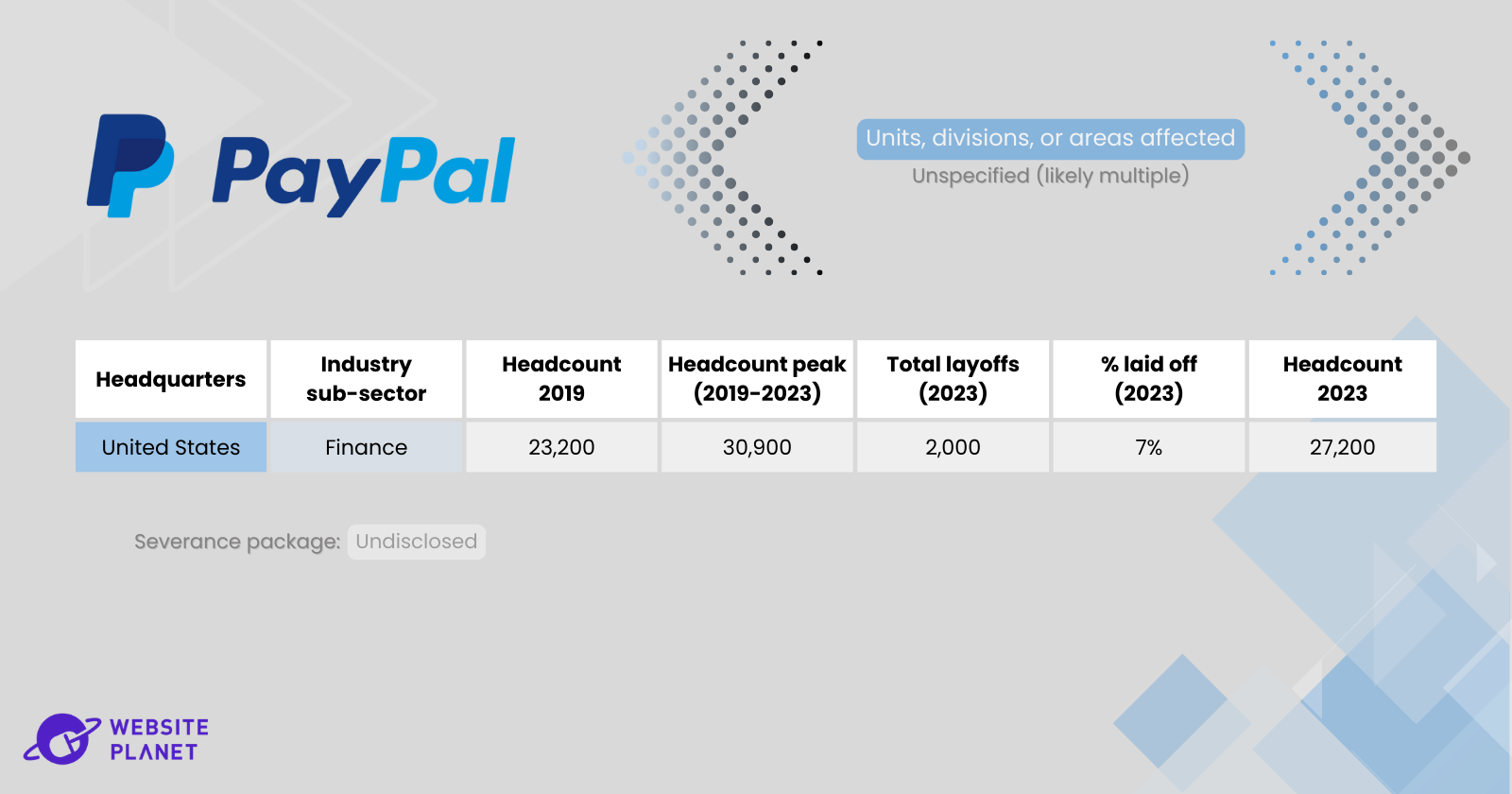 About 7% of PayPal’s headcount was set to be let go in 2023, per an announcement made in January of that year. According to President and CEO Dan Schulman, the restructuring is meant to help the company face the “challenging macroeconomic environment” by allowing it to focus on core priorities and streamline costs.
PayPal shares slipped in the last quarter of 2022 after its posted revenue estimate did not meet analyst forecasts. In its 2022 Q3 earnings report, acting CFO Gabrielle Rabinovich said that inflation pressures would be challenging to navigate but that the company is coming up with plans and guidelines to boost productivity.
About 7% of PayPal’s headcount was set to be let go in 2023, per an announcement made in January of that year. According to President and CEO Dan Schulman, the restructuring is meant to help the company face the “challenging macroeconomic environment” by allowing it to focus on core priorities and streamline costs.
PayPal shares slipped in the last quarter of 2022 after its posted revenue estimate did not meet analyst forecasts. In its 2022 Q3 earnings report, acting CFO Gabrielle Rabinovich said that inflation pressures would be challenging to navigate but that the company is coming up with plans and guidelines to boost productivity.
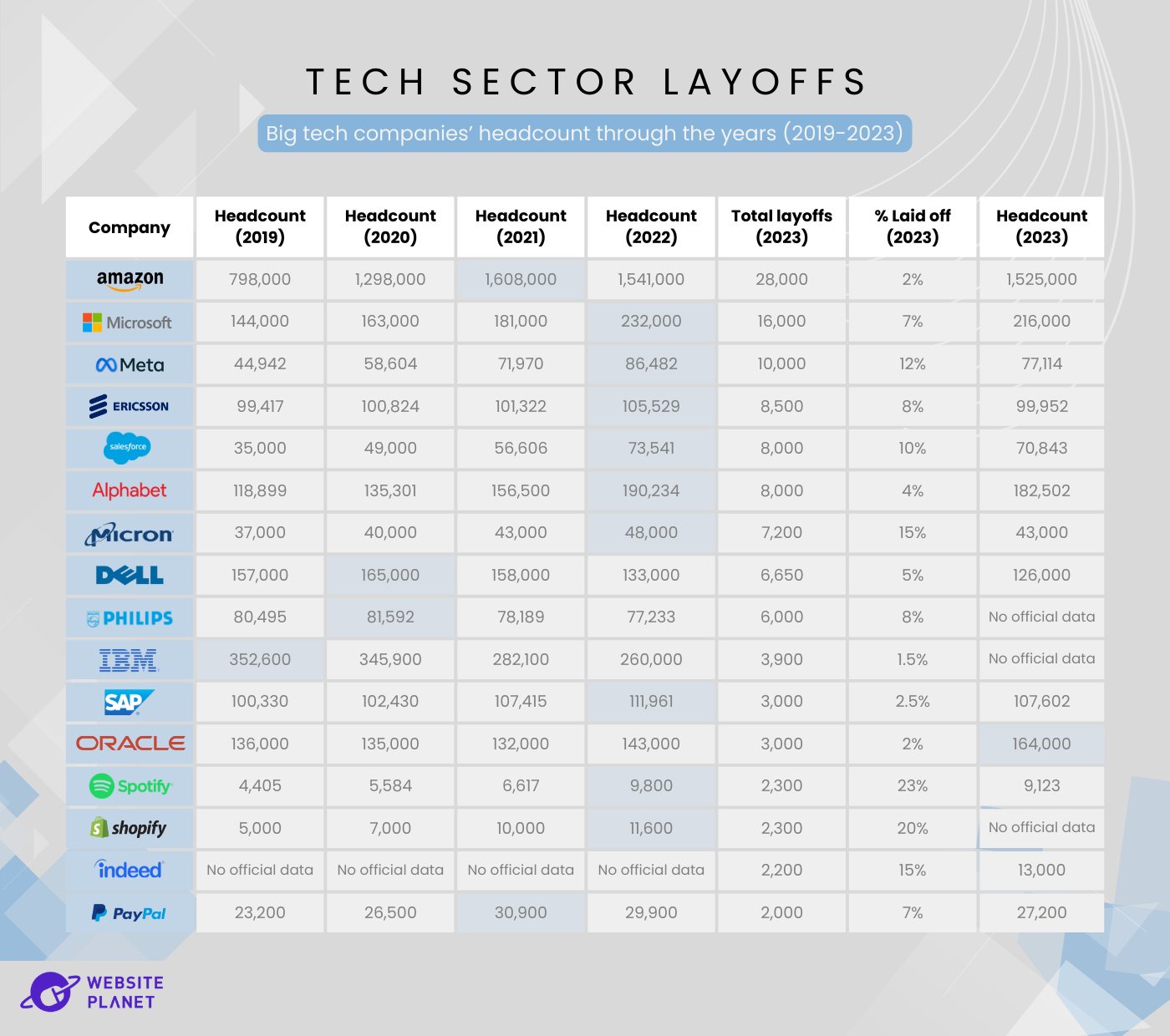
Early Tech Layoffs in 2024
The tech sector entered 2024 with renewed layoffs from at least 195 companies, affecting over 49,000 employees in January and February alone. This information comes after a mid-January pronouncement by Wall Street experts that “January’s layoffs are too small” to impact the labor market. The retail sub-sector saw the most employees laid off in the first months of 2024, with over 6,900 workers cut, followed closely by the consumer sub-sector (almost 6,500 employees). Tech layoffs in 2024 are so far outpacing workforce reductions in the previous year. In 2023, an average of 719 jobs in the tech sector were cut daily, while the first two months of 2024 averaged 823 employee dismissals per day. Companies that implemented big-impact layoffs in 2023 and continued their rounds of reduction in early 2024 include: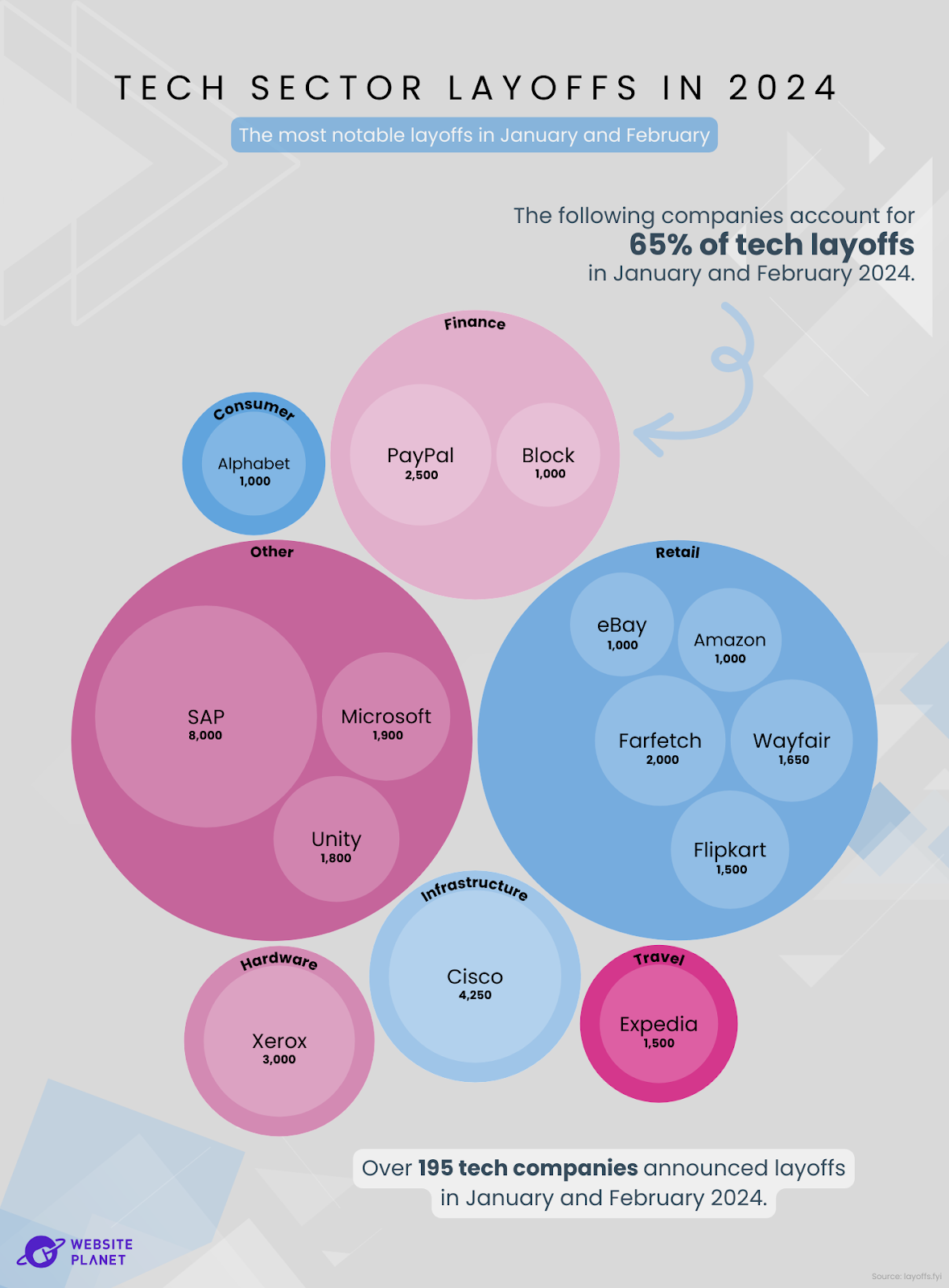
SAP (8,000 employees)
After announcing “only” 3,000 layoffs in 2023, SAP rose to the top of our list of tech giants’ workforce reductions in 2024. The company declared that it would implement voluntary employee buyouts and job changes for 7% of its headcount — or 8,000 workers. Despite the planned restructuring, the company expects that its 2024 workforce will be the same as its last-reported headcount in 2023, which suggests that they are planning to hire as many people as they are laying off.Dell (6,000 employees)
An SEC filing publicized in March 2024 revealed that Dell had 120,000 employees as of February 2, 2024 — 13,000 people fewer than its headcount at the beginning of the previous year. In February 2023, Dell disclosed a layoff affecting “only” 6,650 employees. Most investor analyses point to the “worse than expected” PC demand as the probable cause behind the layoff that seemed to affect double the anticipated number of terminations in 2023. However, it remains unclear when the additional 6,000 people left the company. It is likewise important to note that Dell has mandated a partial return-to-office (RTO) in May 2023, which could have forced workers to vacate their positions. In March 2024, the company doubled down on the policy by announcing that all employees who choose to stay fully remote by May 2024 would not be considered for promotions or role changes. The move has been branded a “stealth layoff” or “quiet firing,” similar to what Amazon was accused of at the end of 2023. In total, Dell eliminated 13,000 positions from 2023 to the beginning of 2024, and more could be expected with the impending implementation of the company’s strict RTO mandate.PayPal (2,500 employees)
Before January 2024 ended, PayPal announced a 2,500-staff reduction that was set to impact around 9% of its total workforce. This figure is larger than the company’s total 2023 layoffs of 2,000 employees. The company’s restructuring was attributed mainly to the increasing competition, which is affecting PayPal’s market position. In 2023, the payments firm’s shares dropped by 20% due to lower-than-predicted earnings. Since the growth of rivals like Apple Pay and Zelle, PayPal seems to be struggling to keep pace, causing analysts to demote its stock.Microsoft (1,900 employees)
Microsoft announced in January 2024 that it plans to cut 1,900 employees from its gaming division. The layoff will impact 8% of the unit, which houses around 22,000 workers. This layoff announcement comes less than four months after Microsoft’s acquisition of Activision Blizzard, an American video game holding company. On the same day the layoffs were announced, Mike Ybarra, President of Activision Blizzard, declared that he was leaving the company.Ericsson (1,200 employees)
Ericsson is continuing its cost-cutting initiatives in 2024, with another 1,200 employees to be eliminated from its payroll in Sweden. The move, announced in March, is reportedly part of a bigger plan to downsize facilities, optimize operations, and reduce consultants. The company cites slower 5G spending as the main driver behind the layoff. In a statement, Ericsson claimed to be anticipating a “challenging mobile networks market” as consumer demand for their 5G equipment continues to drop.Amazon (1,000 employees)
Despite culling its workforce by around 28,000 in 2023, Amazon seems not to be done laying off employees in 2024. An internal memo circulated in the second week of January revealed that the company is yet again removing “several hundred” jobs in its Prime Video and MGM Studios units. This was closely followed by an announcement of a 30-staff layoff in Amazon’s Buy with Prime division. In early February 2024, Amazon cut another 400 from its workforce, this time affecting employees in One Medical and Amazon Pharmacy. Other Amazon-owned businesses also enforced reductions in their workforce. This included Twitch, which published a blog post announcing a layoff affecting 500 workers, and Audible’s over 100-employee decrease, affecting 5% of its headcount. A screenshot of a memo leaked on X (previously Twitter) explained that Audible had a strong 2023, thanks to the “hard work of each and every” employee, but needed to make a “difficult decision” to ensure continued success. Moreover, Amazon’s “silent sacking” or “quiet firing” has continued into 2024. A report by Business Insider revealed that managers were told to place 10% of employees in performance improvement plans (PIP) to meet attrition targets — either voluntary or through firing — of up to 12%.Alphabet (1,000 employees)
In 2023, Alphabet laid off “only” around 8,000 employees instead of its predicted 12,000. However, the company seems to be jumping back on its reduction plans in 2024, as it confirmed in January that around 1,000 employees had been laid off in its engineering and Google Assistant teams. Later that month, reports surfaced that Google’s parent company plans to cut several hundred more workers in its advertising-sales unit and X, the moonshot factory, which is a division that works on “radical new technologies to help solve the world’s hardest problems.”Salesforce (700 employees)
Salesforce continued its round of layoffs in 2023 with a 700-staff reduction (1% of its workforce) in January 2024. At the same time, the company also had 1,000 open positions for hiring, which means that the layoffs could be a move to adjust or refresh the firm’s labor force.Oracle (124 employees)
After laying off over 3,000 employees in its Cerner unit in 2023, Oracle appears not to be letting the division’s headcount plateau. The company declared plans to lay off another 124 employees in Missouri, Cerner’s home state, in January 2024. The layoffs are set to take effect on April 1, 2024, and impact senior managers, project heads, and analysts for their systems, technical, and business units. The affected workers were reportedly working on Oracle’s contract with CoxHealth, a Missouri-based six-hospital healthcare system. In December 2023, CoxHealth announced it would transition from Oracle to Epic One.Others
Other notable 1,000+ layoff announcements made at the beginning of 2024 include:- Tesla: The Elon Musk-owned tech transportation colossus is eliminating upward of 14,000 jobs or over 10% of its workforce. Tesla is reportedly struggling with dropping sales and the continuing price war on electric vehicles, prompting Musk to address the “duplication of roles and job functions in certain areas.”
- Cisco: The digital communications giant is laying off 5% of its workforce, affecting approximately 4,250 employees. Cisco cited a drop in corporate tech expenditure as its primary motivation, likely exacerbated by a 6% decrease in its quarterly revenue as of January 2024.
- Xerox: The print solutions company’s 2023 headcount is to be pared down to around 17,000 employees, cutting 3,000 jobs or approximately 15% of the workforce. Xerox’s headcount has been declining since 2016, after its repeated attempts to keep pace with digital advancements — including introducing new divisions and merging with or acquiring bigger firms — have failed to yield significant results for the company.
- Farfetch: London-based luxury e-retail business Farfetch is culling its workforce by 25%–30%, impacting around 2,000 employees. The layoffs, which began in February 2024, were reportedly made to “streamline the business” and “operate from a position of financial strength.”
- Unity: Video game software development firm Unity is slashing 1,800 employees (25% of its workforce) from its headcount. This round of layoffs is supposedly part of a “company reset” that follows the three rounds of reductions it conducted in 2023, which laid off a total of 1,100 workers.
- Wayfair: The Boston-based e-commerce company is laying off 13% of its total workforce or 1,650 employees. Like most tech companies, Wayfair traced the move to pandemic overhiring, which has now required it to streamline management processes.
- Expedia: Digital travel agency Expedia is cutting 1,500 roles from its workforce to allow it to “invest in core strategic areas for growth.” The company is reportedly treating the layoffs as a significant bid for an “organizational and technological transformation,” potentially enabling it to keep pace with the declining travel market.
- Flipkart: After a hiring freeze in 2023, e-commerce business Flipkart will cull its workforce by 5%–7%, or up to 1,500 employees, to reduce operational expenses. The company expects to finish its layoffs by March or April 2024.
- eBay: E-commerce giant eBay is set to eliminate 1,000 jobs (9% of its full-time workforce) after it said that the company’s operational expenses have “outpaced” the business’s growth. It is also reportedly planning to pare down on alternate workforce contracts later in 2024.
- Block: The financial services firm owned by Jack Dorsey, co-founder and former CEO of X (previously Twitter), is eliminating around 1,000 employees from its payroll (10% of its workforce). The initiative will impact workers in the Square, Cash App, and Afterpay divisions as Block seeks to end 2024 with an “absolute” maximum of 12,000 employees.




